beginner's guide to literary analysis
Understanding literature & how to write literary analysis.
Literary analysis is the foundation of every college and high school English class. Once you can comprehend written work and respond to it, the next step is to learn how to think critically and complexly about a work of literature in order to analyze its elements and establish ideas about its meaning.
If that sounds daunting, it shouldn’t. Literary analysis is really just a way of thinking creatively about what you read. The practice takes you beyond the storyline and into the motives behind it.
While an author might have had a specific intention when they wrote their book, there’s still no right or wrong way to analyze a literary text—just your way. You can use literary theories, which act as “lenses” through which you can view a text. Or you can use your own creativity and critical thinking to identify a literary device or pattern in a text and weave that insight into your own argument about the text’s underlying meaning.
Now, if that sounds fun, it should , because it is. Here, we’ll lay the groundwork for performing literary analysis, including when writing analytical essays, to help you read books like a critic.

What Is Literary Analysis?
As the name suggests, literary analysis is an analysis of a work, whether that’s a novel, play, short story, or poem. Any analysis requires breaking the content into its component parts and then examining how those parts operate independently and as a whole. In literary analysis, those parts can be different devices and elements—such as plot, setting, themes, symbols, etcetera—as well as elements of style, like point of view or tone.
When performing analysis, you consider some of these different elements of the text and then form an argument for why the author chose to use them. You can do so while reading and during class discussion, but it’s particularly important when writing essays.
Literary analysis is notably distinct from summary. When you write a summary , you efficiently describe the work’s main ideas or plot points in order to establish an overview of the work. While you might use elements of summary when writing analysis, you should do so minimally. You can reference a plot line to make a point, but it should be done so quickly so you can focus on why that plot line matters . In summary (see what we did there?), a summary focuses on the “ what ” of a text, while analysis turns attention to the “ how ” and “ why .”
While literary analysis can be broad, covering themes across an entire work, it can also be very specific, and sometimes the best analysis is just that. Literary critics have written thousands of words about the meaning of an author’s single word choice; while you might not want to be quite that particular, there’s a lot to be said for digging deep in literary analysis, rather than wide.
Although you’re forming your own argument about the work, it’s not your opinion . You should avoid passing judgment on the piece and instead objectively consider what the author intended, how they went about executing it, and whether or not they were successful in doing so. Literary criticism is similar to literary analysis, but it is different in that it does pass judgement on the work. Criticism can also consider literature more broadly, without focusing on a singular work.
Once you understand what constitutes (and doesn’t constitute) literary analysis, it’s easy to identify it. Here are some examples of literary analysis and its oft-confused counterparts:
Summary: In “The Fall of the House of Usher,” the narrator visits his friend Roderick Usher and witnesses his sister escape a horrible fate.
Opinion: In “The Fall of the House of Usher,” Poe uses his great Gothic writing to establish a sense of spookiness that is enjoyable to read.
Literary Analysis: “Throughout ‘The Fall of the House of Usher,’ Poe foreshadows the fate of Madeline by creating a sense of claustrophobia for the reader through symbols, such as in the narrator’s inability to leave and the labyrinthine nature of the house.
In summary, literary analysis is:
- Breaking a work into its components
- Identifying what those components are and how they work in the text
- Developing an understanding of how they work together to achieve a goal
- Not an opinion, but subjective
- Not a summary, though summary can be used in passing
- Best when it deeply, rather than broadly, analyzes a literary element
Literary Analysis and Other Works
As discussed above, literary analysis is often performed upon a single work—but it doesn’t have to be. It can also be performed across works to consider the interplay of two or more texts. Regardless of whether or not the works were written about the same thing, or even within the same time period, they can have an influence on one another or a connection that’s worth exploring. And reading two or more texts side by side can help you to develop insights through comparison and contrast.
For example, Paradise Lost is an epic poem written in the 17th century, based largely on biblical narratives written some 700 years before and which later influenced 19th century poet John Keats. The interplay of works can be obvious, as here, or entirely the inspiration of the analyst. As an example of the latter, you could compare and contrast the writing styles of Ralph Waldo Emerson and Edgar Allan Poe who, while contemporaries in terms of time, were vastly different in their content.
Additionally, literary analysis can be performed between a work and its context. Authors are often speaking to the larger context of their times, be that social, political, religious, economic, or artistic. A valid and interesting form is to compare the author’s context to the work, which is done by identifying and analyzing elements that are used to make an argument about the writer’s time or experience.
For example, you could write an essay about how Hemingway’s struggles with mental health and paranoia influenced his later work, or how his involvement in the Spanish Civil War influenced his early work. One approach focuses more on his personal experience, while the other turns to the context of his times—both are valid.
Why Does Literary Analysis Matter?
Sometimes an author wrote a work of literature strictly for entertainment’s sake, but more often than not, they meant something more. Whether that was a missive on world peace, commentary about femininity, or an allusion to their experience as an only child, the author probably wrote their work for a reason, and understanding that reason—or the many reasons—can actually make reading a lot more meaningful.
Performing literary analysis as a form of study unquestionably makes you a better reader. It’s also likely that it will improve other skills, too, like critical thinking, creativity, debate, and reasoning.
At its grandest and most idealistic, literary analysis even has the ability to make the world a better place. By reading and analyzing works of literature, you are able to more fully comprehend the perspectives of others. Cumulatively, you’ll broaden your own perspectives and contribute more effectively to the things that matter to you.
Literary Terms to Know for Literary Analysis
There are hundreds of literary devices you could consider during your literary analysis, but there are some key tools most writers utilize to achieve their purpose—and therefore you need to know in order to understand that purpose. These common devices include:
- Characters: The people (or entities) who play roles in the work. The protagonist is the main character in the work.
- Conflict: The conflict is the driving force behind the plot, the event that causes action in the narrative, usually on the part of the protagonist
- Context : The broader circumstances surrounding the work political and social climate in which it was written or the experience of the author. It can also refer to internal context, and the details presented by the narrator
- Diction : The word choice used by the narrator or characters
- Genre: A category of literature characterized by agreed upon similarities in the works, such as subject matter and tone
- Imagery : The descriptive or figurative language used to paint a picture in the reader’s mind so they can picture the story’s plot, characters, and setting
- Metaphor: A figure of speech that uses comparison between two unlike objects for dramatic or poetic effect
- Narrator: The person who tells the story. Sometimes they are a character within the story, but sometimes they are omniscient and removed from the plot.
- Plot : The storyline of the work
- Point of view: The perspective taken by the narrator, which skews the perspective of the reader
- Setting : The time and place in which the story takes place. This can include elements like the time period, weather, time of year or day, and social or economic conditions
- Symbol : An object, person, or place that represents an abstract idea that is greater than its literal meaning
- Syntax : The structure of a sentence, either narration or dialogue, and the tone it implies
- Theme : A recurring subject or message within the work, often commentary on larger societal or cultural ideas
- Tone : The feeling, attitude, or mood the text presents
How to Perform Literary Analysis
Step 1: read the text thoroughly.
Literary analysis begins with the literature itself, which means performing a close reading of the text. As you read, you should focus on the work. That means putting away distractions (sorry, smartphone) and dedicating a period of time to the task at hand.
It’s also important that you don’t skim or speed read. While those are helpful skills, they don’t apply to literary analysis—or at least not this stage.
Step 2: Take Notes as You Read
As you read the work, take notes about different literary elements and devices that stand out to you. Whether you highlight or underline in text, use sticky note tabs to mark pages and passages, or handwrite your thoughts in a notebook, you should capture your thoughts and the parts of the text to which they correspond. This—the act of noticing things about a literary work—is literary analysis.
Step 3: Notice Patterns
As you read the work, you’ll begin to notice patterns in the way the author deploys language, themes, and symbols to build their plot and characters. As you read and these patterns take shape, begin to consider what they could mean and how they might fit together.
As you identify these patterns, as well as other elements that catch your interest, be sure to record them in your notes or text. Some examples include:
- Circle or underline words or terms that you notice the author uses frequently, whether those are nouns (like “eyes” or “road”) or adjectives (like “yellow” or “lush”).
- Highlight phrases that give you the same kind of feeling. For example, if the narrator describes an “overcast sky,” a “dreary morning,” and a “dark, quiet room,” the words aren’t the same, but the feeling they impart and setting they develop are similar.
- Underline quotes or prose that define a character’s personality or their role in the text.
- Use sticky tabs to color code different elements of the text, such as specific settings or a shift in the point of view.
By noting these patterns, comprehensive symbols, metaphors, and ideas will begin to come into focus.
Step 4: Consider the Work as a Whole, and Ask Questions
This is a step that you can do either as you read, or after you finish the text. The point is to begin to identify the aspects of the work that most interest you, and you could therefore analyze in writing or discussion.
Questions you could ask yourself include:
- What aspects of the text do I not understand?
- What parts of the narrative or writing struck me most?
- What patterns did I notice?
- What did the author accomplish really well?
- What did I find lacking?
- Did I notice any contradictions or anything that felt out of place?
- What was the purpose of the minor characters?
- What tone did the author choose, and why?
The answers to these and more questions will lead you to your arguments about the text.
Step 5: Return to Your Notes and the Text for Evidence
As you identify the argument you want to make (especially if you’re preparing for an essay), return to your notes to see if you already have supporting evidence for your argument. That’s why it’s so important to take notes or mark passages as you read—you’ll thank yourself later!
If you’re preparing to write an essay, you’ll use these passages and ideas to bolster your argument—aka, your thesis. There will likely be multiple different passages you can use to strengthen multiple different aspects of your argument. Just be sure to cite the text correctly!
If you’re preparing for class, your notes will also be invaluable. When your teacher or professor leads the conversation in the direction of your ideas or arguments, you’ll be able to not only proffer that idea but back it up with textual evidence. That’s an A+ in class participation.
Step 6: Connect These Ideas Across the Narrative
Whether you’re in class or writing an essay, literary analysis isn’t complete until you’ve considered the way these ideas interact and contribute to the work as a whole. You can find and present evidence, but you still have to explain how those elements work together and make up your argument.
How to Write a Literary Analysis Essay
When conducting literary analysis while reading a text or discussing it in class, you can pivot easily from one argument to another (or even switch sides if a classmate or teacher makes a compelling enough argument).
But when writing literary analysis, your objective is to propose a specific, arguable thesis and convincingly defend it. In order to do so, you need to fortify your argument with evidence from the text (and perhaps secondary sources) and an authoritative tone.
A successful literary analysis essay depends equally on a thoughtful thesis, supportive analysis, and presenting these elements masterfully. We’ll review how to accomplish these objectives below.
Step 1: Read the Text. Maybe Read It Again.
Constructing an astute analytical essay requires a thorough knowledge of the text. As you read, be sure to note any passages, quotes, or ideas that stand out. These could serve as the future foundation of your thesis statement. Noting these sections now will help you when you need to gather evidence.
The more familiar you become with the text, the better (and easier!) your essay will be. Familiarity with the text allows you to speak (or in this case, write) to it confidently. If you only skim the book, your lack of rich understanding will be evident in your essay. Alternatively, if you read the text closely—especially if you read it more than once, or at least carefully revisit important passages—your own writing will be filled with insight that goes beyond a basic understanding of the storyline.
Step 2: Brainstorm Potential Topics
Because you took detailed notes while reading the text, you should have a list of potential topics at the ready. Take time to review your notes, highlighting any ideas or questions you had that feel interesting. You should also return to the text and look for any passages that stand out to you.
When considering potential topics, you should prioritize ideas that you find interesting. It won’t only make the whole process of writing an essay more fun, your enthusiasm for the topic will probably improve the quality of your argument, and maybe even your writing. Just like it’s obvious when a topic interests you in a conversation, it’s obvious when a topic interests the writer of an essay (and even more obvious when it doesn’t).
Your topic ideas should also be specific, unique, and arguable. A good way to think of topics is that they’re the answer to fairly specific questions. As you begin to brainstorm, first think of questions you have about the text. Questions might focus on the plot, such as: Why did the author choose to deviate from the projected storyline? Or why did a character’s role in the narrative shift? Questions might also consider the use of a literary device, such as: Why does the narrator frequently repeat a phrase or comment on a symbol? Or why did the author choose to switch points of view each chapter?
Once you have a thesis question , you can begin brainstorming answers—aka, potential thesis statements . At this point, your answers can be fairly broad. Once you land on a question-statement combination that feels right, you’ll then look for evidence in the text that supports your answer (and helps you define and narrow your thesis statement).
For example, after reading “ The Fall of the House of Usher ,” you might be wondering, Why are Roderick and Madeline twins?, Or even: Why does their relationship feel so creepy?” Maybe you noticed (and noted) that the narrator was surprised to find out they were twins, or perhaps you found that the narrator’s tone tended to shift and become more anxious when discussing the interactions of the twins.
Once you come up with your thesis question, you can identify a broad answer, which will become the basis for your thesis statement. In response to the questions above, your answer might be, “Poe emphasizes the close relationship of Roderick and Madeline to foreshadow that their deaths will be close, too.”
Step 3: Gather Evidence
Once you have your topic (or you’ve narrowed it down to two or three), return to the text (yes, again) to see what evidence you can find to support it. If you’re thinking of writing about the relationship between Roderick and Madeline in “The Fall of the House of Usher,” look for instances where they engaged in the text.
This is when your knowledge of literary devices comes in clutch. Carefully study the language around each event in the text that might be relevant to your topic. How does Poe’s diction or syntax change during the interactions of the siblings? How does the setting reflect or contribute to their relationship? What imagery or symbols appear when Roderick and Madeline are together?
By finding and studying evidence within the text, you’ll strengthen your topic argument—or, just as valuably, discount the topics that aren’t strong enough for analysis.

Step 4: Consider Secondary Sources
In addition to returning to the literary work you’re studying for evidence, you can also consider secondary sources that reference or speak to the work. These can be articles from journals you find on JSTOR, books that consider the work or its context, or articles your teacher shared in class.
While you can use these secondary sources to further support your idea, you should not overuse them. Make sure your topic remains entirely differentiated from that presented in the source.
Step 5: Write a Working Thesis Statement
Once you’ve gathered evidence and narrowed down your topic, you’re ready to refine that topic into a thesis statement. As you continue to outline and write your paper, this thesis statement will likely change slightly, but this initial draft will serve as the foundation of your essay. It’s like your north star: Everything you write in your essay is leading you back to your thesis.
Writing a great thesis statement requires some real finesse. A successful thesis statement is:
- Debatable : You shouldn’t simply summarize or make an obvious statement about the work. Instead, your thesis statement should take a stand on an issue or make a claim that is open to argument. You’ll spend your essay debating—and proving—your argument.
- Demonstrable : You need to be able to prove, through evidence, that your thesis statement is true. That means you have to have passages from the text and correlative analysis ready to convince the reader that you’re right.
- Specific : In most cases, successfully addressing a theme that encompasses a work in its entirety would require a book-length essay. Instead, identify a thesis statement that addresses specific elements of the work, such as a relationship between characters, a repeating symbol, a key setting, or even something really specific like the speaking style of a character.
Example: By depicting the relationship between Roderick and Madeline to be stifling and almost otherworldly in its closeness, Poe foreshadows both Madeline’s fate and Roderick’s inability to choose a different fate for himself.
Step 6: Write an Outline
You have your thesis, you have your evidence—but how do you put them together? A great thesis statement (and therefore a great essay) will have multiple arguments supporting it, presenting different kinds of evidence that all contribute to the singular, main idea presented in your thesis.
Review your evidence and identify these different arguments, then organize the evidence into categories based on the argument they support. These ideas and evidence will become the body paragraphs of your essay.
For example, if you were writing about Roderick and Madeline as in the example above, you would pull evidence from the text, such as the narrator’s realization of their relationship as twins; examples where the narrator’s tone of voice shifts when discussing their relationship; imagery, like the sounds Roderick hears as Madeline tries to escape; and Poe’s tendency to use doubles and twins in his other writings to create the same spooky effect. All of these are separate strains of the same argument, and can be clearly organized into sections of an outline.
Step 7: Write Your Introduction
Your introduction serves a few very important purposes that essentially set the scene for the reader:
- Establish context. Sure, your reader has probably read the work. But you still want to remind them of the scene, characters, or elements you’ll be discussing.
- Present your thesis statement. Your thesis statement is the backbone of your analytical paper. You need to present it clearly at the outset so that the reader understands what every argument you make is aimed at.
- Offer a mini-outline. While you don’t want to show all your cards just yet, you do want to preview some of the evidence you’ll be using to support your thesis so that the reader has a roadmap of where they’re going.
Step 8: Write Your Body Paragraphs
Thanks to steps one through seven, you’ve already set yourself up for success. You have clearly outlined arguments and evidence to support them. Now it’s time to translate those into authoritative and confident prose.
When presenting each idea, begin with a topic sentence that encapsulates the argument you’re about to make (sort of like a mini-thesis statement). Then present your evidence and explanations of that evidence that contribute to that argument. Present enough material to prove your point, but don’t feel like you necessarily have to point out every single instance in the text where this element takes place. For example, if you’re highlighting a symbol that repeats throughout the narrative, choose two or three passages where it is used most effectively, rather than trying to squeeze in all ten times it appears.
While you should have clearly defined arguments, the essay should still move logically and fluidly from one argument to the next. Try to avoid choppy paragraphs that feel disjointed; every idea and argument should feel connected to the last, and, as a group, connected to your thesis. A great way to connect the ideas from one paragraph to the next is with transition words and phrases, such as:
- Furthermore
- In addition
- On the other hand
- Conversely

Step 9: Write Your Conclusion
Your conclusion is more than a summary of your essay's parts, but it’s also not a place to present brand new ideas not already discussed in your essay. Instead, your conclusion should return to your thesis (without repeating it verbatim) and point to why this all matters. If writing about the siblings in “The Fall of the House of Usher,” for example, you could point out that the utilization of twins and doubles is a common literary element of Poe’s work that contributes to the definitive eeriness of Gothic literature.
While you might speak to larger ideas in your conclusion, be wary of getting too macro. Your conclusion should still be supported by all of the ideas that preceded it.
Step 10: Revise, Revise, Revise
Of course you should proofread your literary analysis essay before you turn it in. But you should also edit the content to make sure every piece of evidence and every explanation directly supports your thesis as effectively and efficiently as possible.
Sometimes, this might mean actually adapting your thesis a bit to the rest of your essay. At other times, it means removing redundant examples or paraphrasing quotations. Make sure every sentence is valuable, and remove those that aren’t.
Other Resources for Literary Analysis
With these skills and suggestions, you’re well on your way to practicing and writing literary analysis. But if you don’t have a firm grasp on the concepts discussed above—such as literary devices or even the content of the text you’re analyzing—it will still feel difficult to produce insightful analysis.
If you’d like to sharpen the tools in your literature toolbox, there are plenty of other resources to help you do so:
- Check out our expansive library of Literary Devices . These could provide you with a deeper understanding of the basic devices discussed above or introduce you to new concepts sure to impress your professors ( anagnorisis , anyone?).
- This Academic Citation Resource Guide ensures you properly cite any work you reference in your analytical essay.
- Our English Homework Help Guide will point you to dozens of resources that can help you perform analysis, from critical reading strategies to poetry helpers.
- This Grammar Education Resource Guide will direct you to plenty of resources to refine your grammar and writing (definitely important for getting an A+ on that paper).
Of course, you should know the text inside and out before you begin writing your analysis. In order to develop a true understanding of the work, read through its corresponding SuperSummary study guide . Doing so will help you truly comprehend the plot, as well as provide some inspirational ideas for your analysis.
- Link to facebook
- Link to linkedin
- Link to twitter
- Link to youtube
- Writing Tips
How to Write a Perfect Analytical Paragraph

- 8-minute read
- 30th January 2023
If you are looking up how to write an analytical paragraph, you are most likely writing an argumentative or analytical essay. Analytical essays are similar to other essays, such as descriptive essays, in that you have a central idea, organize supporting ideas into body paragraphs, and make conclusions.
However, analytical essays differ from other essays because the writer must go further. They require the writer to interpret and analyze a given text or information using evidence to support their central idea or thesis statement. This analysis takes place in analytical paragraphs, or body paragraphs, if you are writing an analytical essay .
In this article, you’ll learn the components of a perfect analytical paragraph: the topic sentence, evidence, analysis, and conclusion. Keep reading to learn more.
What Is an Analytical Paragraph?
An analytical paragraph is a paragraph that breaks down a piece of literature, an idea, or a concept into smaller parts and analyzes each part to understand the whole. Being able to write an effective and successful analytical paragraph reflects a writer’s critical thinking and organizational writing skills. All in all, like any other type of writing, writing an analytical paragraph requires skill and practice.
Write the Topic Sentence
A topic sentence is usually the first, or sometimes second, sentence at the beginning of anybody paragraph. Your topic sentence should contain one main idea related to the thesis statement . If it is not related to your thesis statement, then you are likely off topic.
Pro Tip: If your topic sentence is the second sentence of your paragraph, then your first sentence should be a transitional sentence .
Let’s look at a thesis statement and some topic sentences to get a better idea.
Topic: Examine and analyze the marriages in George Eliot’s Middlemarch .
Thesis Statement: Eliot uses three different marriages to give depth to everyday people and show the reader the struggles of marriage within the nineteenth century’s societal standards of submissive roles, class range, and financial status.
Topic Sentence 1: Lydgate and Rosamond had a terrible marriage in Middlemarch , like all other marriages during this time.
This topic sentence is not effective because it is not specific enough and does not directly relate to the thesis statement. It does not mention how their “terrible” marriage is related to submissive roles, class range, or financial status. Additionally, the overly generalized language of “all” marriages being terrible marriages during this time is a weak argument.
Topic Sentence 2: Financial matters play a huge role in the Lydgate and Rosamond marriage, as Lydgate has no money and Rosamond is a big spender.
This topic sentence is effective because it directly supports the thesis statement. It is focused on the financial status of this marriage.
Provide Evidence
The type of evidence you use to support your topic sentence will largely depend on the topic of your analytical essay. For example, if you are writing an essay related to a work of literature, you will need to provide direct quotes, paraphrasing, specific details, or a summary from the work to support your main idea. If your topic is related to analyzing data, then you may use figures, statistics, or charts and graph evidence to support your topic sentence.
Regardless of what type of evidence you provide, it must be appropriate and directly relate to and support your topic sentence.
For example, if we take the above thesis and topic sentence, we might select direct quotes, paraphrases, or summaries from the novel Middlemarch that depict the marriage’s financial stress.
Pro Tip: When using direct quotes, make sure you always provide an in-text citation and use correct punctuation to ensure your essay is neat and clean.
Find this useful?
Subscribe to our newsletter and get writing tips from our editors straight to your inbox.
Once you have provided evidence, you should analyze it to illustrate its significance and how it relates to the topic sentence. In your analysis, you can discuss how an author uses certain literary devices to emphasize character traits, themes, patterns, and connections in a literary work.
Be sure that your analysis always connects to the topic sentence/main idea of the paragraph. Avoid introducing new ideas in this section. Save those for later paragraphs or consider creating a new one to explore and analyze the new point.
Conclude Your Paragraph
When closing an analytical paragraph, you can consider doing two things:
● Briefly emphasize the main point your reader should take away after having read the paragraph.
● Begin a transition if the analysis continues into the next paragraph. (This strategy may be more suitable for longer, more in-depth analytical essays).
Using the above example topic sentence, we might conclude the paragraph as follows:
Notice how this concluding statement not only emphasizes the main points from the paragraph but also ties back into the thesis statement.
Writing Tips For Analytical Paragraphs
Leave out first person language.
Avoid using language such as “in my opinion,” “from my perspective,” or “I think.” While the analysis is your interpretation of a text or information, you should rely on and focus on using evidence to support your ideas. Overall, you should aim to maintain an objective tone .
Instead of saying “I think Rosamond is manipulative,” you should use evidence from the text to show that she was manipulative. For example, “Rosamond shows a pattern of manipulation throughout Middlemarch , specifically toward her husband. For instance, she says, ‘…’”
Do Writing Exercises
When writing, especially in the early drafts of an essay, it is typical to find the main idea of a paragraph at the end. This is a natural course for our thinking process. However, the main idea should be presented as your topic sentence at the beginning of this paragraph. Additionally, most students leave this main idea at the end because they do not identify it as the main idea.
To overcome this dilemma, try a looping prewriting exercise . In this exercise, you write continuously for a designated time (maybe 10 minutes, your choice). At the end of that time, read over what you’ve written and circle the main idea of the text (this is usually at the end). In the next cycle, you start with this main idea at the beginning and further examine and analyze it.
This is a wonderful exercise to help you pick out main ideas and delve deeper into your analysis.
Get Feedback
If you are a student, there are several options to get feedback for free. Ask a friend to read your essay. Go to your writing center to get feedback and help with your writing. Go to your professor’s office hours with your writing or questions to get detailed advice. More often than not, they are happy to see you take advantage of their expertise.
As a working professional, writer, or author, you can look to fellow authors or bookish friends to read your work. You can find free beta readers online from sites such as Goodreads to get feedback from your target audience. You can also find writing groups on social media platforms.
Proofread Your Work
It can be easy to finish writing an essay and think “Finally, I’m done!” Unfortunately, that is only half the process. Be sure to always read and reread your writing before hitting submit. Check for stray commas, spelling errors, or awkward sentences to make your main ideas and hard work shine. Learn about 6 Quick and Easy Tips for Proofreading you can do at home.
Writing an analytical paragraph doesn’t have to be stressful. Be sure to include a topic sentence at the beginning of your paragraph that connects to the thesis statement. Provide a variety of evidence to support your main idea, analyze the text by highlighting literary devices used, themes, and patterns, and end with a brief concluding statement.
If you need more help with writing analysis, descriptive essays, or any other type of essay, then Proofed is here to help. Try our free trial today!
What Is a Topic Sentence?
A topic sentence goes at the beginning of a body paragraph and clearly states the main idea of the paragraph.
How Do I Organize an Analytical Paragraph?
An analytical paragraph has four components: topic sentence, evidence, analysis, and conclusion. The topic sentence is the most important part of any body paragraph because it establishes the main idea of the paragraph and relates to the thesis statement.
What Makes a Good Analytical Paragraph?
A good analytical paragraph has a clear topic sentence, strong evidence, and a thorough analysis that reflects the writer’s critical thinking and writing skills. It should conclude by emphasizing the main idea of the paragraph and how it supports the essay overall.
Share this article:
Post A New Comment
Got content that needs a quick turnaround? Let us polish your work. Explore our editorial business services.
4-minute read
The Benefits of Using an Online Proofreading Service
Proofreading is important to ensure your writing is clear and concise for your readers. Whether...
2-minute read
6 Online AI Presentation Maker Tools
Creating presentations can be time-consuming and frustrating. Trying to construct a visually appealing and informative...
What Is Market Research?
No matter your industry, conducting market research helps you keep up to date with shifting...
8 Press Release Distribution Services for Your Business
In a world where you need to stand out, press releases are key to being...
3-minute read
How to Get a Patent
In the United States, the US Patent and Trademarks Office issues patents. In the United...
The 5 Best Ecommerce Website Design Tools
A visually appealing and user-friendly website is essential for success in today’s competitive ecommerce landscape....

Make sure your writing is the best it can be with our expert English proofreading and editing.

Want to create or adapt books like this? Learn more about how Pressbooks supports open publishing practices.
46 Introduction to Analysis Writing
Amy Minervini
by Amy Minervini
Analysis is the process of digging deeper into what we read, see, and hear. This skill is used both in academic writing and in everyday life. In-depth exploration helps us to more effectively understand issues in society and our daily lives, including but not limited to the articles and books we read, the videos we watch, the brands and ads that influence our buying habits, and the songs we listen to. We can analyze authors, subjects, issues, images, and texts of all kinds using various methods of analysis. This chapter will introduce you to rhetorical and visual analysis, text and literary analysis, and cause and effect (another form of analysis).
Key Characteristics
Analysis writing generally exhibits the following:
- Scrutinizing the details of a subject or text and then interpreting those details to show a particular point of view or theme is being conveyed
- Using a subjective point of view, backed up by evidence
- Determining the use of and quality of rhetorical strategies (pathos, ethos, logos, and kairos) used by others, see the Reading and Writing Rhetorically chapter for more information
- An incorporation of ethos, pathos, and logos to help support claims
- Awareness of and critique of bias that seeps in–for more information on this aspect, see the Addressing Bias and Stakeholder Concerns chapter for more information
Essay Types within this Chapter
- Rhetorical Analysis
- Textual (Article) Analysis
- Literary Analysis
- Image Analysis
- Film Analysis
- Cause and Effect
Introduction to Analysis Writing Copyright © 2020 by Amy Minervini is licensed under a Creative Commons Attribution 4.0 International License , except where otherwise noted.
Share This Book
How to Write an Analysis Essay: Examples + Writing Guide
An analysis / analytical essay is a standard assignment in college or university. You might be asked to conduct an in-depth analysis of a research paper, a report, a movie, a company, a book, or an event. In this article, you’ll find out how to write an analysis paper introduction, thesis, main body, and conclusion, and analytical essay example.
Our specialists will write a custom essay specially for you!
So, what is an analytical essay? This type of assignment implies that you set up an argument and analyze it using a range of claims. The claims should be supported by appropriate empirical evidence. Note that you need to explore both the positive and negative sides of the issue fully.
Analytical skills are the key to getting through your academic career. Moreover, they can be useful in many real-life situations. Keep reading this article by Custom-writing experts to learn how to write an analysis!
❓ What Is an Analytical Essay?
- 🤔 Getting Started
📑 Analytical Essay Outline
- 📔 Choosing a Title
- 💁 Writing an Introduction
- 🏋 Writing a Body
- 🏁 Writing a Conclusion
🔗 References
Before you learn how to start an analysis essay, you should understand some fundamentals of writing this type of paper. It implies that you analyze an argument using a range of claims supported by facts . It is essential to understand that in your analysis essay, you’ll need to explore the negative sides of the issue and the positive ones. That’s what distinguishes an analytical essay from, say, a persuasive one.

These are the steps to write an academic paper :
- Review the literature . Before starting any paper, you should familiarize yourself with what has already been written in the field. And the analytical essay is no exception. The easiest way is to search on the web for the information.
- Brainstorm ideas. After you’ve done your search, it is time for a brainstorm! Make a list of topics for your analysis essay, and then choose the best one. Generate your thesis statement in the same way.
- Prepare an outline . Now, when you’ve decided on the topic and the thesis statement of your analytical essay, think of its structure. Below you will find more detailed information on how your paper should be structured.
- Write the first draft. You’ve done a lot of work by now. Congratulations! Your next goal is to write the first version of your analysis essay, using all the notes that you have. Remember, you don’t need to make it perfect!
- Polish your draft. Now take your time to polish and edit your draft to transform it into the paper’s final version.
You are usually assigned to analyze an article, a book, a movie, or an event. If you need to write your analytical essay on a book or an article, you’ll have to analyze the style of the text, its main points, and the author’s purported goals.
Just in 1 hour! We will write you a plagiarism-free paper in hardly more than 1 hour
🤔 Analytical Essay: Getting Started
The key to writing an analysis paper is to choose an argument that you will defend throughout it. For example: maybe you are writing a critical analysis paper on George Orwell’s Animal Farm The first and imperative task is to think about your thesis statement. In the case of Animal Farm , the argument could be:
In Orwell’s Animal Farm , rhetoric and language prove to be more effective ways to keep social control than physical power.
The University of North Carolina at Chapel Hill gives a great explanation of the thesis statement , how to create one, and what its function is.
But that’s not all. Once you have your thesis statement, you need to break down how you will approach your analysis essay to prove your thesis. To do this, follow these steps:
- Define the main goal(s) of your analysis . Remember that it is impossible to address each and every aspect in a single paper. Know your goal and focus on it.
- Conduct research , both online and offline, to clarify the issue contained within your thesis statement.
- Identify the main parts of the issue by looking at each part separately to see how it works.
- Try to clearly understand how each part works.
- Identify the links between the various aspects of the topic .
- By using the information you found, try to solve your main problem .
At this point, you should have a clear understanding of both the topic and your thesis statement. You should also have a clear direction for your analysis paper firmly planted in your mind and recorded in writing.
This will give you what you need to produce the paper’s outline.
Receive a plagiarism-free paper tailored to your instructions. Cut 20% off your first order!
An outline is the starting point for your work. A typical analytical essay features the usual essay structure. A 500-word essay should consist of a one-paragraph introduction, a three-paragraph body, and a one-paragraph conclusion. Find below a great analytical essay outline sample. Feel free to use it as an example when doing your own work!
Analysis Essay: Introduction
- Start with a startling statement or provocative question.
“All animals are equal, but some animals are more equal”. Animal Farm abounds in ironic and provocative phrases to start an analytical essay.
- Introduce the work and its author.
- Give background information that would help the reader understand your opinion.
- Formulate a thesis statement informing the reader about the purpose of the essay. Essay format does not presuppose telling everything possible on the given topic. Thus, a thesis statement tells what you are going to say, implying what you will not discuss, establishing the limits.
In Animal Farm, Orwell uses different irony types to ridicule totalitarianism to manifest its inability to make every member of society equal and happy.
Analysis Essay: Body
The analytical essay structure requires 2-3 developmental paragraphs, each dedicated to one separate idea confirming your thesis statement. The following template should be used for each of the body paragraphs.
- Start with a topic sentence that supports an aspect of your thesis.
Dramatic irony is used in Animal Farm to point out society’s ignorance.
- Continue with textual evidence (paraphrase, summary, direct quotations, specific details). Use several examples that substantiate the topic sentence.
Animals are unaware of the fact that Boxer was never sent to the hospital. He was sent to the slaughterhouse. However, the reader and writer understand that this is a lie.
- Conclude with an explanation.
By allowing the readers to learn some essential facts before the characters, dramatic irony creates suspense and shows how easy it is to persuade and manipulate the public.
Analysis Essay Conclusion
The next four points will give you a short instruction on how to conclude an analytical essay.
- Never use new information or topics here.
- Restate your thesis in a different formulation.
- Summarize the body paragraphs.
- Comment on the analyzed text from a new perspective.
📔 Choosing a Title for Your Analysis Essay
Choosing a title seems like not a significant step, but it is actually very important. The title of your critical analysis paper should:
- Entice and engage the reader
- Be unique and capture the readers’ attention
- Provide an adequate explanation of the content of the essay in just a few carefully chosen words
In the Animal Farm example, your title could be:
Get an originally-written paper according to your instructions!
“How Do the Pigs Manage to Keep Social Control on Animal Farm?”
Analysis Essay Topics
- Analyze the media content.
- Analyze the specifics and history of hip-hop culture.
- Sociological issues in the film Interstellar .
- Discuss the techniques M. Atwood uses to describe social issues in her novel The Handmaid’s Tale .
- Compare and analyze the paintings of Van Gogh and George Seurat.
- Analysis of Edgar Allan Poe’s The Black Cat .
- Examine the juvenile crime rates.
- Describe the influence of different parenting styles on children’s mind.
- Analyze the concept of the Ship of Theseus .
- Compare and analyze the various views on intelligence .
- Analysis of The Yellow Wallpaper by Charlotte Perkins Gilman .
- Discuss the techniques used by W. Shakespeare in A Midsummer Night’s Dream .
- Analyze the biography of Frederic Chopin .
- Manifestation of the Chicano culture in the artwork An Ofrenda for Dolores del Rio .
- Similarities and differences of Roman, Anglo-Saxon, and Spanish Empires .
- Describe the problem of stalking and its impact on human mental health.
- Examine the future of fashion .
- Analyze the topicality of the article Effectiveness of Hand Hygiene Interventions in Reducing Illness Absence .
- Discuss Thomas Paine’s impact on the success of American revolution.
- Meaningful messages in Recitatif by Toni Morrison .
- Explore the techniques used by directors in the film Killing Kennedy .
- Compare the leadership styles of Tang Empress Wu Zetian and the Pharaoh Cleopatra .
- Evaluate the credibility of Kristof’s arguments in his article Remote Learning Is Often an Oxymoron .
- Analyze genetically modified food .
- Examine the influence of Europeans on Indian tribes in The Narrative of the Captivity and Restoration of Mrs. Mary Rowlandson .
- Describe the rhetoric techniques used in The Portrait of Dorian Gray by Oscar Wilde .
- The importance of fighting against violence in communities in the documentary film The Interrupters .
- Analyze indoor and outdoor pollution .
- Analyze the issue of overprotective parenthood .
- Explore the connection between eating habits and advertisement.
- Discuss the urgence of global warming issue .
- Influence of sleep on people’s body and mental health.
- Analyze the relationship between Christianity and sports .
- Discuss the concept of leadership and its significance for company efficiency.
- Analyze the key lessons of the book Rich Dad Poor Dad by Robert Kiyosaki .
- Examine the specifics of nursing ethic .
- The theme of emotional sufferings in the short story A Rose for Emily .
- Analysis of bias in books for children .
- Analyze the rhetoric of the article Public Monuments .
- Describe the main messages in Jean-Paul Sartre’s Nausea .
- Explore the problem of structural racism in healthcare .
- The reasons of tango dance popularity.
- The shortcomings of the American educational system in Waiting for Superman.
- Analyze and compare Erin’s Law and Megan’s Law .
- Analyze the James Madison’s essay Federalist 10 .
- Examine symbols in the movie The Joker .
- Compare the thematic connection and stylistic devices in the poems The Road Not Taken and Find Your Way .
- Describe and analyze the life of Eddie Bernice Johnson .
- Explore the social classes in America .
- Crucial strengths and weaknesses of the main translation theories .
💁 Writing Your Analytical Essay Introduction
You must understand how to compose an introduction to an analysis paper. The University of Wollongong describes the introduction as a “map” of any writing. When writing the introduction, follow these steps:
- Provide a lead-in for the reader by offering a general introduction to the topic of the paper.
- Include your thesis statement , which shifts the reader from the generalized introduction to the specific topic and its related issues to your unique take on the essay topic.
- Present a general outline of the analysis paper.
Watch this great video for further instructions on how to write an introduction to an analysis essay.
Example of an Analytical Essay Introduction
“Four legs good, two legs bad” is one of the many postulates invented by George Orwell for his characters in Animal Farm to vest them with socialist ideology and control over the animal population. The social revolution on Manor Farm was built on language instruments, first for the collective success of the animals, and later for the power consolidation by the pigs. The novel was written in 1945 when the transition from limitless freedoms of socialist countries transformed into dictatorship. Through his animal protagonists, the author analyzes the reasons for peoples’ belief in the totalitarian regime. In Orwell’s Animal Farm , rhetoric and language prove to be more effective ways to keep social control than physical power.
🏋 Writing Your Analytical Essay Body
The body of the paper may be compared to its heart. This is the part where you show off your talent for analysis by providing convincing, well-researched, and well-thought-out arguments to support your thesis statement. You have already gathered the information, and now all you may start crafting your paper.
To make the body of an analytical essay, keep the following in mind:
- Discuss one argument per paragraph , although each argument can relate to multiple issues
- Strike a balance between writing in an unbiased tone, while expressing your personal opinion
- Be reasonable when making judgments regarding any of the problems you discuss
- Remember to include the opposing point of view to create a balanced perspective
The bottom line is: you want to offer opposing views, but you must pose your arguments so they will counter those opposing views and prove your point of view. Follow these steps when constructing each body paragraph:
- Choose the main sentence. The main or topic sentence will be the first line in your essay. The topic sentence is responsible for presenting the argument you will discuss in the paragraph and demonstrate how this argument relates to the thesis statement.
- Provide the context for the topic sentence , whether it relates to a quote, a specific incident in society, or something else. Offer evidence on who, what, where, when, why, and how.
- Give your analysis of the argument and how it adequately proves your thesis.
- Write a closing sentence that sums up the paragraph and provides a transition to the following paragraph.
Example of an Analytical Essay Body
Literacy can grant power, provided that there are animals who cannot read or write. In the beginning, the animals’ literacy and intellect are relatively the same. Old Major is the cleverest pig; he is the kind old philosopher, like Karl Marx or Vladimir Lenin. During his retirement, he develops a theory that all humans are the root of evil. His speech was the foundation for the pigs’ assumption of power. They refined his ideas into a new ideology and called it Animalism. They also learned how to read. It allowed the pigs to declare themselves the “mind workers.” Therefore, the pigs’ literacy assured the illiterate animals in their objective superiority.
Meanwhile, as the pigs were the intellectual elite, they were not supposed to work, which raised their social status by itself. Snowball tried to promote education among all the animals, but most of them failed to master the alphabet. This is a metaphor for the general public being predominantly ignorant and easy to manipulate. At the same time, Boxer and other animals that spend most of the day in hard work merely have no time to develop their intellect. Thus, the pigs’ intention to build a school for pig children was highly efficient. Unequal access to education and unequal ability to express one’s thoughts in perspective reinforce the social divide, making the pigs smarter and more powerful and undermining other animals’ self-esteem.
At this point, the pigs resort to propaganda and rhetoric. Squealer uses his oratorical gift to refine the pigs’ message to the other animals. Upon Napoleon’s order, he breaks the Seven Commandments of farm governance. At night, he climbs the ladder to change them, and once even falls from the ladder trying to change the commandment on alcohol. The “proletarian” animals soon forget what the Seven Commandments were like in the first place and are unsure if they have ever been altered. Further on, Minimus writes a poem praising Napoleon. Finally, Squealer replaces the Commandments with a single assertion: “All animals are equal, but some animals are more equal than others.” Language is no longer used to convince. It is used to control and manipulate.
🏁 Writing Your Analytical Essay Conclusion
The conclusion is short and sweet. It summarizes everything you just wrote in the essay and wraps it up with a beautiful shiny bow. Follow these steps to write a convincing conclusion:
- Repeat the thesis statement and summarize your argument. Even when using the best summary generator for the task, reread it to make sure all the crucial points are included.
- Take your argument beyond what is simply stated in your paper. You want to show how it is essential in terms of the bigger picture. Also, you may dwell on the influence on citizens of the country.
Example of an Analytical Essay Conclusion
Because of everything mentioned above, it becomes clear that language and rhetoric can rise to power, establish authority, and manipulate ordinary people. Animal Farm is the simplified version of a communist society. It shows how wise philosophers’ good intentions can be used by mean leaders to gain unopposed power and unconditional trust. Unfortunately, this can lead to the death of many innocent animals, i.e., people, as totalitarianism has nothing to do with people’s rule. Therefore, language and oratory are potent tools that can keep people oppressed and weak, deprive them of any chance for improvement and growth, and make them think that there is no other possible existence.
Now you are ready to write an analysis essay! See, it’s easier than you thought.
Of course, it’s always helpful to see other analysis essay examples. The University of Arkansas at Little Rock provides some great examples of an analytical paper .
✏️ Analysis Essay FAQ
A great analytical paper should be well-structured, cohesive, and logically consistent. Each part of the essay should be in its place, creating a smooth and easy-to-read text. Most importantly, the statements should be objective and backed by arguments and examples.
It is a paper devoted to analyzing a certain topic or subject. An analysis essay is all about reviewing certain details of the subject and interpreting them. For example, such an analysis for a poem includes a description of artistic means that helped the poet convey the idea.
Writing an analytical essay on a book/movie/poem start with an outline. Point out what catches the eye when reviewing the subject. See how these details can be interpreted. Make sure that you refer to the main idea/message. Add an appropriate introduction and a logical conclusion.
Being more analytical in writing can be essential for a student. This is a skill that can be self-taught: try to start noticing subtle details and describe them. As you write, interpret the facts and strive to draw conclusions. Try to be as objective as possible.
- Elements of Analysis
- How Can I Create Stronger Analysis?
- How to Write a Literary Analysis Essay: Bucks.edu
- Essay Structure | – Harvard College Writing Center
- Analytical Writing: Looking Closely (Colostate.edu)
- Analytical Thesis Statements – University of Arizona
- Writing an analytic essay – UTSC – University of Toronto
- Organizing Your Analysis // Purdue Writing Lab
- How to Write an Analytical Essay: 15 Steps (with Pictures)
- Share to Facebook
- Share to Twitter
- Share to LinkedIn
- Share to email

A film analysis essay might be the most exciting assignment you have ever had! After all, who doesn’t love watching movies? You have your favorite movies, maybe something you watched years ago, perhaps a classic, or a documentary. Or your professor might assign a film for you to make a...

A critique paper is an academic writing genre that summarizes and gives a critical evaluation of a concept or work. Or, to put it simply, it is no more than a summary and a critical analysis of a specific issue. This type of writing aims to evaluate the impact of...

What is a creative essay, if not the way to express yourself? Crafting such a paper is a task that allows you to communicate your opinion and tell a story. However, even using your imagination to a great extent doesn’t free you from following academic writing rules. Don’t even get...

A compare and contrast essay — what is it? In this type of paper, you compare two different things or ideas, highlighting what is similar between the two, and you also contrast them, highlighting what is different. The two things might be events, people, books, points of view, lifestyles, or...

What is an expository essay? This type of writing aims to inform the reader about the subject clearly, concisely, and objectively. The keyword here is “inform”. You are not trying to persuade your reader to think a certain way or let your own opinions and emotions cloud your work. Just stick to the...
![analysis and essays Short Story Analysis: How to Write It Step by Step [New]](https://custom-writing.org/blog/wp-content/uploads/2020/12/man-sits-end-trolltunga-before-mountains-284x153.jpg)
Have you ever tried to write a story analysis but ended up being completely confused and lost? Well, the task might be challenging if you don’t know the essential rules for literary analysis creation. But don’t get frustrated! We know how to write a short story analysis, and we are...

Have you ever tried to get somebody round to your way of thinking? Then you should know how daunting the task is. Still, if your persuasion is successful, the result is emotionally rewarding. A persuasive essay is a type of writing that uses facts and logic to argument and substantiate...
![analysis and essays Common Essay Mistakes—Writing Errors to Avoid [Updated]](https://custom-writing.org/blog/wp-content/uploads/2020/12/avoid-mistakes-ccw-284x153.jpg)
One of the most critical skills that students gain during their college years is assignment writing. Composing impressive essays and research papers can be quite challenging, especially for ESL students. Nonetheless, before learning the art of academic writing, you may make numerous common essay mistakes. Such involuntary errors appear in:...

You’re probably thinking: I’m no Mahatma Gandhi or Steve Jobs—what could I possibly write in my memoir? I don’t even know how to start an autobiography, let alone write the whole thing. But don’t worry: essay writing can be easy, and this autobiography example for students is here to show...
![analysis and essays Why I Want to Be a Teacher Essay: Writing Guide [2024]](https://custom-writing.org/blog/wp-content/uploads/2020/12/senior-male-professor-writing-blackboard-with-chalk3-284x153.jpg)
Some people know which profession to choose from childhood, while others decide much later in life. However, and whenever you come to it, you may have to elaborate on it in your personal statement or cover letter. This is widely known as “Why I Want to Be a Teacher” essay.
![analysis and essays Friendship Essay: Writing Guide & Topics on Friendship [New]](https://custom-writing.org/blog/wp-content/uploads/2020/12/smiley-female-friends-fist-bumping-284x153.jpg)
Assigned with an essay about friendship? Congrats! It’s one of the best tasks you could get. Digging through your memories and finding strong arguments for this paper can be an enjoyable experience. I bet you will cope with this task effortlessly as we can help you with the assignment. Just...

When you are assigned an autobiography to write, tens, and even hundreds of questions start buzzing in your head. How to write autobiography essay parts? What to include? How to make your autobiography writing flow? Don’t worry about all this and use the following three simple principles and 15 creative...
This resource helps me a lot. Thanks! You guys have great information. Do you think I can use these steps when taking a test? Could it be known as plagiarized if I just copy and paste the information?

Glad to help, Hazel! You can use it in your test but you should cite it accordingly
Thanks, very good information.
Thank you for your attention, Jaweria🙂!
Thanks for learning how to critique research papers in a proper way! This is what I need to cope with this task successfully! Thanks!
How much is an essay, and is there a chance it can be plagiarized?
You have to remember that the price for our services depends on a lot of factors. You can find the detailed price quote here: https://custom-writing.org/prices (the page will be opened in a new window). You can check out the prices depending on the subjects and deadlines that you choose. No – it can’t be plagiarized: the papers are written from scratch according to your instructions. We also stress the importance of the fact that you CAN’T, under any circumstances, use our final product as your own work – the papers, which we provide, are to be used for research purposes only!
- PRO Courses Guides New Tech Help Pro Expert Videos About wikiHow Pro Upgrade Sign In
- EDIT Edit this Article
- EXPLORE Tech Help Pro About Us Random Article Quizzes Request a New Article Community Dashboard This Or That Game Popular Categories Arts and Entertainment Artwork Books Movies Computers and Electronics Computers Phone Skills Technology Hacks Health Men's Health Mental Health Women's Health Relationships Dating Love Relationship Issues Hobbies and Crafts Crafts Drawing Games Education & Communication Communication Skills Personal Development Studying Personal Care and Style Fashion Hair Care Personal Hygiene Youth Personal Care School Stuff Dating All Categories Arts and Entertainment Finance and Business Home and Garden Relationship Quizzes Cars & Other Vehicles Food and Entertaining Personal Care and Style Sports and Fitness Computers and Electronics Health Pets and Animals Travel Education & Communication Hobbies and Crafts Philosophy and Religion Work World Family Life Holidays and Traditions Relationships Youth
- Browse Articles
- Learn Something New
- Quizzes Hot
- This Or That Game New
- Train Your Brain
- Explore More
- Support wikiHow
- About wikiHow
- Log in / Sign up
- Finance and Business
- Business Skills
- Business Writing
How to Write an Analysis
Last Updated: March 28, 2024 Fact Checked
This article was co-authored by Christopher Taylor, PhD and by wikiHow staff writer, Megaera Lorenz, PhD . Christopher Taylor is an Adjunct Assistant Professor of English at Austin Community College in Texas. He received his PhD in English Literature and Medieval Studies from the University of Texas at Austin in 2014. There are 14 references cited in this article, which can be found at the bottom of the page. This article has been fact-checked, ensuring the accuracy of any cited facts and confirming the authority of its sources. This article has been viewed 288,942 times.
An analysis is a piece of writing that looks at some aspect of a document in detail. To write a good analysis, you’ll need to ask yourself questions that focus on how and why the document works the way it does. You can start the process by gathering information about the subject of your analysis and defining the questions your analysis will answer. Once you’ve outlined your main arguments, look for specific evidence to support them. You can then work on putting your analysis together into a coherent piece of writing.
Gathering Information and Building Your Argument

- If your analysis is supposed to answer a specific question or focus on a particular aspect of the document you are analyzing.
- If there are any length or formatting requirements for the analysis.
- The citation style your instructor wants you to use.
- On what criteria your instructor will evaluate your analysis (e.g., organization, originality, good use of references and quotations, or correct spelling and grammar).

- The title of the document (if it has one).
- The name of the creator of the document. For example, depending on the type of document you’re working with, this could be the author, artist, director, performer, or photographer.
- The form and medium of the document (e.g., “Painting, oil on canvas”).
- When and where the document was created.
- The historical and cultural context of the work.

- Who you believe the intended audience is for the advertisement.
- What rhetorical choices the author made to persuade the audience of their main point.
- What product is being advertised.
- How the poster uses images to make the product look appealing.
- Whether there is any text in the poster, and, if so, how it works together with the images to reinforce the message of the ad.
- What the purpose of the ad is or what its main point is.

- For example, if you’re analyzing an advertisement poster, you might focus on the question: “How does this poster use colors to symbolize the problem that the product is intended to fix? Does it also use color to represent the beneficial results of using the product?”

- For example, you might write, “This poster uses the color red to symbolize the pain of a headache. The blue elements in the design represent the relief brought by the product.”
- You could develop the argument further by saying, “The colors used in the text reinforce the use of colors in the graphic elements of the poster, helping the viewer make a direct connection between the words and images.”

- For example, if you’re arguing that the advertisement poster uses red to represent pain, you might point out that the figure of the headache sufferer is red, while everyone around them is blue. Another piece of evidence might be the use of red lettering for the words “HEADACHE” and “PAIN” in the text of the poster.
- You could also draw on outside evidence to support your claims. For example, you might point out that in the country where the advertisement was produced, the color red is often symbolically associated with warnings or danger.
Tip: If you’re analyzing a text, make sure to properly cite any quotations that you use to support your arguments. Put any direct quotations in quotation marks (“”) and be sure to give location information, such as the page number where the quote appears. Additionally, follow the citation requirements for the style guide assigned by your instructor or one that's commonly used for the subject matter you're writing about.
Organizing and Drafting Your Analysis

- For example, “The poster ‘Say! What a relief,’ created in 1932 by designer Dorothy Plotzky, uses contrasting colors to symbolize the pain of a headache and the relief brought by Miss Burnham’s Pep-Em-Up Pills. The red elements denote pain, while blue ones indicate soothing relief.”
Tip: Your instructor might have specific directions about which information to include in your thesis statement (e.g., the title, author, and date of the document you are analyzing). If you’re not sure how to format your thesis statement or topic sentence, don’t hesitate to ask.

- a. Background
- ii. Analysis/Explanation
- iii. Example
- iv. Analysis/Explanation
- III. Conclusion

- For example, “In the late 1920s, Kansas City schoolteacher Ethel Burnham developed a patent headache medication that quickly achieved commercial success throughout the American Midwest. The popularity of the medicine was largely due to a series of simple but eye-catching advertising posters that were created over the next decade. The poster ‘Say! What a relief,’ created in 1932 by designer Dorothy Plotzky, uses contrasting colors to symbolize the pain of a headache and the relief brought by Miss Burnham’s Pep-Em-Up Pills.”

- Make sure to include clear transitions between each argument and each paragraph. Use transitional words and phrases, such as “Furthermore,” “Additionally,” “For example,” “Likewise,” or “In contrast . . .”
- The best way to organize your arguments will vary based on the individual topic and the specific points you are trying to make. For example, in your analysis of the poster, you might start with arguments about the red visual elements and then move on to a discussion about how the red text fits in.

- For example, you might end your essay with a few sentences about how other advertisements at the time might have been influenced by Dorothy Plotzky’s use of colors.

- For example, in your discussion of the advertisement, avoid stating that you think the art is “beautiful” or that the advertisement is “boring.” Instead, focus on what the poster was supposed to accomplish and how the designer attempted to achieve those goals.
Polishing Your Analysis

- For example, if your essay currently skips around between discussions of the red and blue elements of the poster, consider reorganizing it so that you discuss all the red elements first, then focus on the blue ones.

- For example, you might look for places where you could provide additional examples to support one of your major arguments.

- For example, if you included a paragraph about Dorothy Plotzky’s previous work as a children’s book illustrator, you may want to cut it if it doesn’t somehow relate to her use of color in advertising.
- Cutting material out of your analysis may be difficult, especially if you put a lot of thought into each sentence or found the additional material really interesting. Your analysis will be stronger if you keep it concise and to the point, however.

- You may find it helpful to have someone else go over your essay and look for any mistakes you might have missed.
Tip: When you’re reading silently, it’s easy to miss typos and other small errors because your brain corrects them automatically. Reading your work out loud can make problems easier to spot.
Sample Analysis Outline and Conclusion

Expert Q&A

You Might Also Like

- ↑ https://lsa.umich.edu/sweetland/undergraduates/writing-guides/how-do-i-make-sure-i-understand-an-assignment-.html
- ↑ https://www.bucks.edu/media/bcccmedialibrary/pdf/HOWTOWRITEALITERARYANALYSISESSAY_10.15.07_001.pdf
- ↑ https://owl.purdue.edu/owl/general_writing/visual_rhetoric/analyzing_visual_documents/elements_of_analysis.html
- ↑ https://lsa.umich.edu/sweetland/undergraduates/writing-guides/how-can-i-create-stronger-analysis-.html
- ↑ https://lsa.umich.edu/sweetland/undergraduates/writing-guides/how-do-i-decide-what-i-should-argue-.html
- ↑ https://lsa.umich.edu/sweetland/undergraduates/writing-guides/how-do-i-effectively-integrate-textual-evidence-.html
- ↑ https://writingcenter.uagc.edu/writing-a-thesis
- ↑ https://owl.purdue.edu/owl/general_writing/visual_rhetoric/analyzing_visual_documents/organizing_your_analysis.html
- ↑ https://lsa.umich.edu/sweetland/undergraduates/writing-guides/how-do-i-write-an-intro--conclusion----body-paragraph.html
- ↑ http://utminers.utep.edu/omwilliamson/engl0310/Textanalysis.htm
- ↑ https://owl.purdue.edu/owl/graduate_writing/graduate_writing_topics/graduate_writing_organization_structure_new.html
- ↑ https://owl.purdue.edu/owl/general_writing/mechanics/sentence_clarity.html
- ↑ https://writingcenter.unc.edu/tips-and-tools/conciseness-handout/
- ↑ https://writingcenter.unc.edu/tips-and-tools/editing-and-proofreading/
About This Article

If you need to write an analysis, first look closely at your assignment to make sure you understand the requirements. Then, gather background information about the document you’ll be analyzing and do a close read so that you’re thoroughly familiar with the subject matter. If it’s not already specified in your assignment, come up with one or more specific question’s you’d like your analysis to answer, then outline your main arguments. Finally, gather evidence and examples to support your arguments. Read on to learn how to organize, draft, and polish your analysis! Did this summary help you? Yes No
- Send fan mail to authors
Did this article help you?

Featured Articles

Trending Articles

Watch Articles

- Terms of Use
- Privacy Policy
- Do Not Sell or Share My Info
- Not Selling Info
wikiHow Tech Help Pro:
Develop the tech skills you need for work and life

Developing Deeper Analysis & Insights
Analysis is a central writing skill in academic writing. Essentially, analysis is what writers do with evidence to make meaning of it. While there are specific disciplinary types of analysis (e.g., rhetorical, discourse, close reading, etc.), most analysis involves zooming into evidence to understand how the specific parts work and how their specific function might relate to a larger whole. That is, we usually need to zoom into the details and then reflect on the larger picture. In this writing guide, we cover analysis basics briefly and then offer some strategies for deepening your analysis. Deepening your analysis means pushing your thinking further, developing a more insightful and interesting answer to the “so what?” question, and elevating your writing.
Analysis Basics
Questions to Ask of the Text:
- Is the evidence fully explained and contextualized? Where in the text/story does this evidence come from (briefly)? What do you think the literal meaning of the quote/evidence is and why? Why did you select this particular evidence?
- Are you selecting a long enough quote to work with and analyze? While over-quoting can be a problem, so too can under-quoting.
- Do you connect each piece of evidence explicitly to the claim or focus of the paper?
Strategies & Explanation
- Sometimes turning the focus of the paper into a question can really help someone to figure out how to work with evidence. All evidence should answer the question--the work of analysis is explaining how it answers the question.
- The goal of evidence in analytical writing is not just to prove that X exists or is true, but rather to show something interesting about it--to push ideas forward, to offer insights about a quote. To do this, sometimes having a full sentence for a quote helps--if a writer is only using single-word quotes, for example, they may struggle to make meaning out of it.
Deepening Analysis
Not all of these strategies work every time, but usually employing one of them is enough to really help elevate the ideas and intellectual work of a paper:
- Bring the very best point in each paragraph into the topic sentence. Often these sentences are at the very end of a paragraph in a solid draft. When you bring it to the front of the paragraph, you then need to read the paragraph with the new topic sentence and reflect on: what else can we say about this evidence? What else can it show us about your claim?
- Complicate the point by adding contrasting information, a different perspective, or by naming something that doesn’t fit. Often we’re taught that evidence needs to prove our thesis. But, richer ideas emerge from conflict, from difference, from complications. In a compare and contrast essay, this point is very easy to see--we get somewhere further when we consider how two things are different. In an analysis of a single text, we might look at a single piece of evidence and consider: how could this choice the writer made here be different? What other choices could the writer have made and why didn’t they? Sometimes naming what isn’t in the text can help emphasize the importance of a particular choice.
- Shift the focus question of the essay and ask the new question of each piece of evidence. For example, a student is looking at examples of language discrimination (their evidence) in order to make an argument that answers the question: what is language discrimination? Questions that are definitional (what is X? How does Y work? What is the problem here?) can make deeper analysis challenging. It’s tempting to simply say the equivalent of “Here is another example of language discrimination.” However, a strategy to help with this is to shift the question a little bit. So perhaps the paragraphs start by naming different instances of language discrimination, but the analysis then tackles questions like: what are the effects of language discrimination? Why is language discrimination so problematic in these cases? Who perpetuates language discrimination and how? In a paper like this, it’s unlikely you can answer all of those questions--but, selecting ONE shifted version of a question that each paragraph can answer, too, helps deepen the analysis and keeps the essay focused.
- Examine perspective--both the writer’s and those of others involved with the issue. You might reflect on your own perspectives as a unique audience/reader. For example, what is illuminated when you read this essay as an engineer? As a person of color? As a first-generation student at Cornell? As an economically privileged person? As a deeply religious Christian? In order to add perspective into the analysis, the writer has to name these perspectives with phrases like: As a religious undergraduate student, I understand X to mean… And then, try to explain how the specificity of your perspective illuminates a different reading or understanding of a term, point, or evidence. You can do this same move by reflecting on who the intended audience of a text is versus who else might be reading it--how does it affect different audiences differently? Might that be relevant to the analysis?
- Qualify claims and/or acknowledge limitations. Before college level writing and often in the media, there is a belief that qualifications and/or acknowledging the limitations of a point adds weakness to an argument. However, this actually adds depth, honesty, and nuance to ideas. It allows you to develop more thoughtful and more accurate ideas. The questions to ask to help foster this include: Is this always true? When is it not true? What else might complicate what you’ve said? Can we add nuance to this idea to make it more accurate? Qualifications involve words like: sometimes, may effect, often, in some cases, etc. These terms are not weak or to be avoided, they actually add accuracy and nuance.
A Link to a PDF Handout of this Writing Guide
Purdue Online Writing Lab Purdue OWL® College of Liberal Arts
Organizing Your Analysis

Welcome to the Purdue OWL
This page is brought to you by the OWL at Purdue University. When printing this page, you must include the entire legal notice.
Copyright ©1995-2018 by The Writing Lab & The OWL at Purdue and Purdue University. All rights reserved. This material may not be published, reproduced, broadcast, rewritten, or redistributed without permission. Use of this site constitutes acceptance of our terms and conditions of fair use.
This resource covers how to write a rhetorical analysis essay of primarily visual texts with a focus on demonstrating the author’s understanding of the rhetorical situation and design principles.
There is no one perfect way to organize a rhetorical analysis essay. In fact, writers should always be a bit leery of plug-in formulas that offer a perfect essay format. Remember, organization itself is not the enemy, only organization without considering the specific demands of your particular writing task. That said, here are some general tips for plotting out the overall form of your essay.
Introduction
Like any rhetorical analysis essay, an essay analyzing a visual document should quickly set the stage for what you’re doing. Try to cover the following concerns in the initial paragraphs:
- Make sure to let the reader know you’re performing a rhetorical analysis. Otherwise, they may expect you to take positions or make an evaluative argument that may not be coming.
- Clearly state what the document under consideration is and possibly give some pertinent background information about its history or development. The intro can be a good place for a quick, narrative summary of the document. The key word here is “quick, for you may be dealing with something large (for example, an entire episode of a cartoon like the Simpsons). Save more in-depth descriptions for your body paragraph analysis.
- If you’re dealing with a smaller document (like a photograph or an advertisement), and copyright allows, the introduction or first page is a good place to integrate it into your page.
- Give a basic run down of the rhetorical situation surrounding the document: the author, the audience, the purpose, the context, etc.
Thesis Statements and Focus
Many authors struggle with thesis statements or controlling ideas in regards to rhetorical analysis essays. There may be a temptation to think that merely announcing the text as a rhetorical analysis is purpose enough. However, especially depending on your essay’s length, your reader may need a more direct and clear statement of your intentions. Below are a few examples.
1. Clearly narrow the focus of what your essay will cover. Ask yourself if one or two design aspects of the document is interesting and complex enough to warrant a full analytical treatment.
The website for Amazon.com provides an excellent example of alignment and proximity to assist its visitors in navigating a potentially large and confusing amount of information.
2. Since visual documents often seek to move people towards a certain action (buying a product, attending an event, expressing a sentiment), an essay may analyze the rhetorical techniques used to accomplish this purpose. The thesis statement should reflect this goal.
The call-out flyer for the Purdue Rowing Team uses a mixture of dynamic imagery and tantalizing promises to create interest in potential, new members.
3. Rhetorical analysis can also easily lead to making original arguments. Performing the analysis may lead you to an argument; or vice versa, you may start with an argument and search for proof that supports it.
A close analysis of the female body images in the July 2007 issue of Cosmopolitan magazine reveals contradictions between the articles’ calls for self-esteem and the advertisements’ unrealistic, beauty demands.
These are merely suggestions. The best measure for what your focus and thesis statement should be the document itself and the demands of your writing situation. Remember that the main thrust of your thesis statement should be on how the document creates meaning and accomplishes its purposes. The OWl has additional information on writing thesis statements.
Analysis Order (Body Paragraphs)
Depending on the genre and size of the document under analysis, there are a number of logical ways to organize your body paragraphs. Below are a few possible options. Which ever you choose, the goal of your body paragraphs is to present parts of the document, give an extended analysis of how that part functions, and suggest how the part ties into a larger point (your thesis statement or goal).
Chronological
This is the most straight-forward approach, but it can also be effective if done for a reason (as opposed to not being able to think of another way). For example, if you are analyzing a photo essay on the web or in a booklet, a chronological treatment allows you to present your insights in the same order that a viewer of the document experiences those images. It is likely that the images have been put in that order and juxtaposed for a reason, so this line of analysis can be easily integrated into the essay.
Be careful using chronological ordering when dealing with a document that contains a narrative (i.e. a television show or music video). Focusing on the chronological could easily lead you to plot summary which is not the point of a rhetorical analysis.
A spatial ordering covers the parts of a document in the order the eye is likely to scan them. This is different than chronological order, for that is dictated by pages or screens where spatial order concerns order amongst a single page or plane. There are no unwavering guidelines for this, but you can use the following general guidelines.
- Left to right and top to down is still the normal reading and scanning pattern for English-speaking countries.
- The eye will naturally look for centers. This may be the technical center of the page or the center of the largest item on the page.
- Lines are often used to provide directions and paths for the eye to follow.
- Research has shown that on web pages, the eye tends to linger in the top left quadrant before moving left to right. Only after spending a considerable amount of time on the top, visible portion of the page will they then scroll down.
Persuasive Appeals
The classic, rhetorical appeals are logos, pathos, and ethos. These concepts roughly correspond to the logic, emotion, and character of the document’s attempt to persuade. You can find more information on these concepts elsewhere on the OWL. Once you understand these devices, you could potentially order your essay by analyzing the document’s use of logos, ethos, and pathos in different sections.
The conclusion of a rhetorical analysis essay may not operate too differently from the conclusion of any other kind of essay. Still, many writers struggle with what a conclusion should or should not do. You can find tips elsewhere on the OWL on writing conclusions. In short, however, you should restate your main ideas and explain why they are important; restate your thesis; and outline further research or work you believe should be completed to further your efforts.

origin story
Baynard woods the supreme court's originalism is white supremacy.

morality play
I was detained by iran's morality police. unlike mahsa amini, i got out alive..
The terror women face is so common that everyone has either experienced it firsthand or knows someone close who has.
Parnaz Foroutan
Salman Rushdie's stabbing is part of an American phenomenon

Health care for all
When i started growing breasts as a teen boy, i got gender-affirming care without stigma.
Justin T. Brown

the world through dirty glasses
Why people like my mother will continue to believe in alex jones no matter what.
Sarah Mullens

Bitter pill
Debunking the billion-dollar multivitamin myth.
Timothy Caulfield
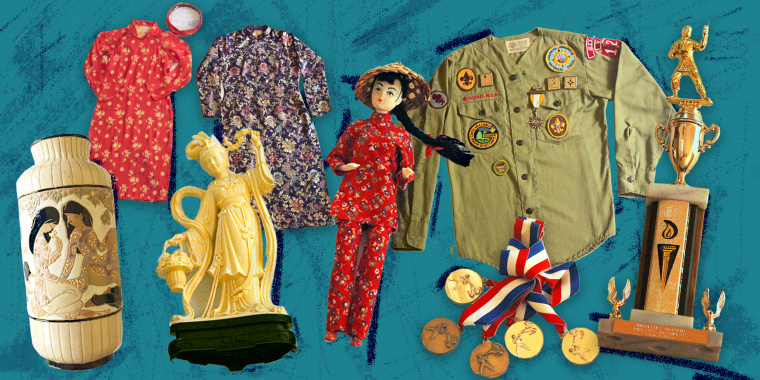
preserving joy
Marie kondo's advice threatens the cultural heritage of refugees, 2022's silver linings.
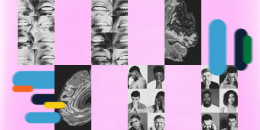
Why humans think things are so much worse than they are

Predictions that Trump would kill our democracy in 2022 were premature

Russia-Ukraine war has shocked Putin — and military vets like me

Here's what saved the economy in 2022

What 2022's box-office hits told us about this cultural pastime

Why our worst fears about Covid in 2022 weren't realized

Tom Brady is finally going to lose. What a relief.
Mavericks with ari melber.
A series of in-depth conversations with artists, musicians and cultural icons.

Top Politics & Policy

If it walks like a duck
How this weapon the u.s. is giving ukraine can help push out russia.

zero-sum game
Katie porter is a solid senate candidate, but her run could be a disaster for democrats.

hard choices
One sure way biden can push trump into a corner using jan. 6.

Winning through losing
The surprise winners of kevin mccarthy's embarrassing speaker food fight.

democracy in action
Those mocking the gop speaker vote don’t seem to get democracy.

Right of way
Don't blame the weather for flight delays. here's who's at fault., top health & technology.

good intentions
I’m a psychologist with an autistic child. this diagnostic aid leaves me conflicted..

put to the test
Is the dna in the idaho case foolproof.

a broken system
I’m an er doctor. treating emergencies is only a fraction of what i do..

criminal behavior
'sextortion' is ruining teens' lives. here's how we can protect them..

speech seduction
Elon musk's 'twitter files' debacle underscores the concerning allure of his favorite theory.

Time to take precautions
Respiratory diseases are still killing people. we need to mask up again., top culture & lifestyle.

Conflicting opinions
Want to improve your mental health and relationships lean in to conflict..

playing with fire
'm3gan' does what it needs to as a horror film — but gets one thing wrong.

Most celebrity 'nepo baby' responses make them look worse. Not this one.

Man of contradictions
How benedict tried to take on clergy child abuse, and how he failed us.

the weight of it all
The ableist wellness programs that assault fat employees this time of year.

Hollywood's beauty myth
The damaging trickle-down effects of hollywood's last big taboo, get the think newsletter, want great think content delivered weekly to your inbox sign up for our newsletter, we want to hear what you think.
Let us know what you THINK by submitting a letter to the editor.
Follow THINK on Twitter
THINK is NBC News' home for fresh opinion, sharp analysis and powerful essays.

Culture & Lifestyle
'alice, darling' isn't your average thriller.
Noah Berlatsky

Politics & Policy
My new co-worker george santos is a liar, a disgrace — and a danger to democracy.
Rep. Ritchie Torres
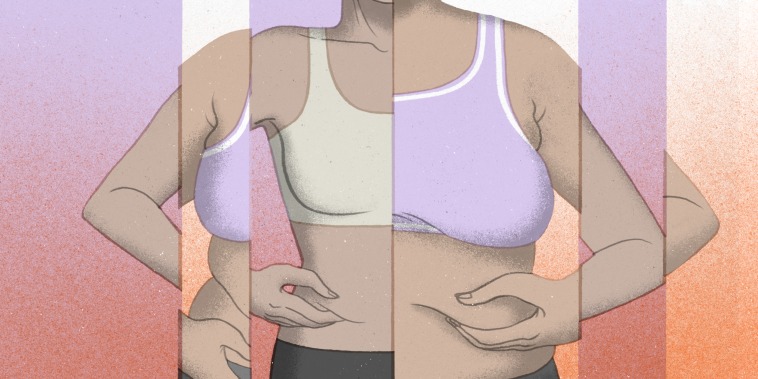
How this old-fashioned eating disorder stereotype hurts people like me
Erin Harrop

One more thing for Democrats to fix: the Republican Party
Neal Urwitz
More Politics & Policy

Why the Bruce's Beach $20 million sale isn't a model for reparations

Kevin McCarthy's House speakership fiasco tells us what we can kiss goodbye

We've been getting blizzard planning all wrong

Rep.-elect Santos can't get indicted for lying. How it could still be used against him.

The biggest mistake Democrats made when they asked for Trump's taxes

Trump has officially run out of moves on his tax returns. Here's why that matters.

Cities are experimenting with free buses. So far, so good.

Title 42 is only the start of Biden’s anti-immigrant policies

Jan. 6 transcript mockery highlights a disappointing misunderstanding

Now is the time to tell Zelenskyy U.S. aid has its limits
More health & tech.

Health & Technology
The 6-year-old accused of shooting his teacher shouldn’t be punished under the law.


Why raising this tax could save lives

If we don't want sick kids being sent to school, this is what we need to do

The difference between toys that are bestsellers and actually best

The founders of Bitcoin must hate the crypto revolution

Why lab-grown meat is far better than the meat we already eat

Elon Musk's Twitter hypocrisy highlights a depressing truth about the modern workplace

'I'm the problem, it's me:' Why Ticketmaster's Taylor Swift meltdown was so revealing

Many are laughing at Musk’s Twitter Blue failure. Here’s the not so funny part.

Selena Gomez deconstructs her own image in her new doc, “My Mind & Me”
More culture & lifestyle.

'Spare' reveals a sadder, smaller truth than Prince Harry may want to admit

Damar Hamlin's cardiac arrest is an imperfect metaphor for a brutal reality

These narcissists poisoned society in 2022. Goodbye to all that.

Listen to your inner child when it tells you to 'shut up'

Netflix's 'The Witcher' prequel won't fix the show's Henry Cavill problem

When my husband brought home a fake Christmas tree, I considered divorce

I can't control the abundance of gifts others buy for my kids. But here is what I can.

Megan Thee Stallion was slut-shamed on the stand and in the court of public opinion

Why 'Women Talking' isn't your typical Hollywood story about rape

'I Wanna Dance With Somebody' shows us the harm in trying to squeeze Blackness into a box

This bombshell Jan. 6 report legal conclusion could actually end Trump's comeback

The thing that would be so much worse for Trump than an indictment

Allegations against Rep.-elect George Santos aren’t only embarrassing for Republicans

The Jan. 6 committee referred Trump to the Justice Department. That was a mistake.

The Jan. 6 committee is about to release a lot of information. Here's what to focus on.

The white male grievances at the center of the latest 'Yellowstone' prequel

Giuliani faces disbarment for bringing a frivolous suit. Why that doesn't happen more.
Russia-ukraine conflict.

The U.S. is welcoming Finland and Sweden to NATO. That’s a mistake.

Why Putin's latest weapon is so troubling

A crucial key to rebuilding Ukraine is in trouble

Those pushing Ukraine to concede territory need to listen to Putin's recent words

Why the U.S. is more likely to fight on Taiwan's behalf than Ukraine's
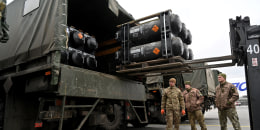
Why the U.S. is succeeding in Ukraine after failing in Iraq and Afghanistan

Putin's war crimes arrest would be a game changer — and it's no longer a pipe dream

The disturbing reason why the myth that Hitler had Jewish roots endures
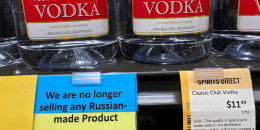
Boycotts of Russian goods and people reveal an ugly prejudice

Why Russia is using dolphins to guard its navy ships. No, that’s not a code name.

Why I'm not surprised Russian soldiers are accused of rape

Russia and Ukraine peace talks likely have nothing to do with 'peace'

We need something in Ukraine that we haven’t gotten from our Western allies yet

What’s behind the change of heart Slovakians are having toward refugees

Why Zelenskyy is likely wrong when he accuses Putin of genocide at Bucha

Americans are leaning right on Ukraine — and giving the GOP a lifeline

One of the worst ways Putin is gaslighting the world on Ukraine

There goes European unity
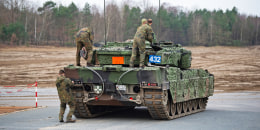
Why it took so long for Europe to understand that it needs to defend itself

The secret to the Ukrainian military’s success

As a Russian immigrant, I'm feeling judged in America

How Ukraine can win this war

During WWII my parents' generation had the foresight to do what many Ukrainians are doing

How this surreal Biden speech from 2009 foreshadowed Putin's invasion

Republicans have more than just a Trump problem on their hands

My grandparents' escape from war brought trauma that never ended

WHAT DO YOU THINK?
We want to hear what you think. please submit a letter to the editor..

RETHINK YOUR WEEK
Do you miss being in an English classroom? and I am not talking about the having to take tests and write essays. I mean being able to sit and listen to your teacher and your peers discuss books and to put your heads together to create meaning. Well that is what I am trying to recreate on my Channel. I create videos about books that do more than summarize what happen. I dig deep into plot structure, character development, and the themes of the book. We will discuss meaningful quotes and look at moments in the book that really matter. I love books, and I love talking about books. So come join my community of book lovers and subscribe to this channel.
According to your English Teacher Sam
- MAR 27, 2024
Tom Lake: Critical Analysis
Tom Lake by Anne Pachett is a book about a family living together on a farm during the pandemic. During their free time their mother Laura tells them about her life and her time at Tom Lake with the famous Peter Duke. In this episode we look at the plot structure, delve into the themes, and discuss the characters in this book.
- MAR 21, 2024
The Women: Deep Dive into topics Women & War
In this episode we will be tracking the two themes in this book. We will be looking at Women and War. These two themes are intertwined in the book, so it is perfect to look at both of them together. This book had so many powerful scenes, so we will take a look at those as we explore The Women.
- MAR 14, 2024
The Women by Kristen Hannah
In this episode we will be unpacking the book, The Women by Kristen Hannah. This book is about a young woman, Frankie McGrath, who joins the Army to become a nurse in The Vietnam War. This was a moving piece that honors the veterans in The Vietnam War, but gives special focus to the women who dedicated their lives to saving others.
- © 2024 According to your English Teacher
Top Podcasts In Arts
Analytical Essay: Tips, Structure, Examples

Analytical essays could be perfect for you if you enjoy immersing yourself in tasks and excel at thinking creatively. By conducting thorough analysis and employing innovative writing techniques, you can discover new viewpoints and enhance your understanding of the subject.
In this article, our research paper writer will explain what it entails, learn how to structure your paper for top marks, snag some snazzy topic ideas, and glean practical examples. This guide has got all the essentials you need for writing success!
What Is an Analytical Essay
To write an effective analytical essay, it is important to understand its purpose and method. In basic terms, it requires using textual evidence to logically support the author's arguments rather than relying on emotions or personal anecdotes. Compared to persuasive essays that advocate for one specific viewpoint, a quality analytical essay example should delve into all aspects of the subject. This involves examining different perspectives, dissecting arguments, and assessing evidence thoughtfully. Ultimately, you will have to express your viewpoint after conducting your analysis. This requires combining your research and determining if you agree with the conclusions made or have a different interpretation.
Wondering How to Impress Your Professor with Your Essay?
Let our writers craft you a winning essay, no matter the subject, field, type, or length!
How to Structure an Analytical Essay
Now it's time to ace the process of crafting an excellent paper. To make writing easier, organize your thoughts and structure your arguments clearly. An analytical essay needs the introduction, body, and conclusion of an outline, which acts as a guide from start to finish. Here's the simple breakdown of an analytical essay outline:
.webp)
Introduction
- Background information
- Thesis statement
Body paragraph 1
- Topic sentence
- Supporting evidence
- Transition to the body paragraph to
Body paragraph 2
- Transition to body paragraph 3
Body paragraph 3
- Transition to conclusion
- Summary of major points
- Restate the thesis
- Key takeaways
Introduction: To begin your essay successfully (see our analytical essay example), captivate the reader's interest from the very start and clearly outline the topic. A good beginning should give some background information, outline the essay's purpose, and suggest the main arguments that will be made. Grab the reader's attention with an engaging and pertinent opening sentence, such as a surprising fact, a funny story, or a challenging question. After that, introduce your thesis statement, which summarizes your main point in the essay.
Body Paragraphs: In an analysis essay, each paragraph begins with a topic sentence that helps guide the reader. The paragraph then provides evidence to support the thesis, concentrating on a single issue. By summarizing the main point at the end of each paragraph, the essay flows smoothly from one idea to the next, maintaining clarity and coherence in the argument.
Conclusion: The final paragraph of an analytical essay usually adheres to a specific structure:
- Reiterating the main argument
- Outlining the main ideas discussed in the essay
- Providing thoughts on the overall significance of the analysis
It is crucial to include your perspective on the topic's relevance and how your analysis adds to the understanding of it. This approach can strongly impact the reader's perception of the essay.
Meanwhile, you might also be interested in how to write a reflection paper , so check out the article for more information!
How to Write an Analytical Essay
Once you understand the structure, there are some steps you can take to make writing an analytical essay easier. Preparing beforehand can simplify the process and improve the overall flow and structure of your essay. Here are some tips from our experts. Meanwhile, you can also request from our experts - write my essay for me . And we'll take care of it right away.
.webp)
- Think Ahead : Before writing, a good analytical essay writer should spend some time thinking about the topic. Make a list of ideas or themes related to it. This helps you find interesting angles for your essay.
- Create a Thesis Statement : Develop a clear and concise thesis statement that outlines the main argument of your essay. This will guide you in how to write an analytical essay introduction and keep your writing focused.
- Visualize Information : Use graphs or charts to organize your thoughts visually. This makes your research easier to understand. For example, you can compare ideas with a chart.
- Consider Different Views : Address opposing viewpoints in your essay. This shows you've thought about different perspectives and strengthens your argument.
- Use Original Sources : Include interviews, presentations, or original documents in your research. They give a unique insight into your topic. For instance, old letters can offer personal views on historical events.
- Analyze Cause and Effect : Explore the cause-and-effect relationships within your topic. Analyze how different factors contribute to certain outcomes or phenomena.
Analytical Essay Topics
Choosing the right one among lots of analytical essay topic ideas is crucial when tackling your essay. Here's a guide to help you pick wisely:
- Find a topic that piques your interest. It's easier to dive into analysis when you're passionate about the subject.
- Look for topics that catch the reader's eye. Think about what would make someone stop and want to read more.
- Avoid topics that are too broad. Focus on something specific that you can thoroughly analyze within the scope of your essay.
- Ensure there's enough quality research available to support your analysis. You'll need evidence to back up your points.
- Your topic should raise questions worth exploring. Aim for something that sparks curiosity and has significance.
Now, here's a mix of engaging topics from our dissertation services to consider:
- Analyzing the Impact of Blue Light from Screens on Sleep Quality
- Exploring the Environmental Effects of Microplastics in Ocean Ecosystems
- Understanding the Benefits of Deep Breathing Exercises for Anxiety Relief
- Analyzing the Influence of Instagram Filters on Body Image Perception
- Exploring the Health Risks of Artificial Sweeteners in Diet Soda
- Understanding the Psychological Effects of High-Intensity Interval Training (HIIT)
- Analyzing the Environmental Impact of Fast Food Packaging Waste
- Exploring the Effects of Social Media Validation on Self-Esteem
- Understanding the Benefits of Indoor Plants for Air Quality Improvement
- Analyzing the Relationship Between Sugar Consumption and Dental Health
- Exploring the Psychological Effects of Online Shopping Addiction
- Understanding the Environmental Impact of Fast Fashion Textile Dyes
- Analyzing the Effects of Smartphone Notifications on Focus and Productivity
- Exploring the Benefits of Outdoor Exercise for Vitamin D Production
- Understanding the Relationship Between Noise Pollution and Cardiovascular Health
- Analyzing the Psychological Effects of Colorful Food Presentation on Appetite
- Exploring the Impact of Petting Therapy Dogs on Stress Reduction
- Understanding the Benefits of Classical Music for Concentration While Studying
- Analyzing the Effects of Lavender Aromatherapy on Sleep Quality
- Exploring the Health Risks of Prolonged Sitting and Sedentary Lifestyles
Analytical Essay Examples
Here is our analytical writing sample to see theory in action. Notice how analytical thinking applies to real-world situations, improving your understanding of concepts. By studying these examples, you'll learn to analyze complex issues, build strong arguments, and sharpen your critical thinking skills.
Final Thoughts
With our tips on how to write an analytical essay and examples, you're ready to boost your writing skills and craft essays that captivate your audience. With practice, you'll become a pro at analytical writing, ready to tackle any topic with confidence.
And hey, if you need help to buy essay online , just drop us a line saying ' do my homework for me ' and we'll jump right in!
Do Analytical Essays Tend to Intimidate You?
Give us your assignment to uncover a deeper understanding of your chosen analytical essay topic!
How to Write an Analytical Essay?
What is an analytical essay, what is the purpose of an analytical essay, related articles.
.webp)
Home — Essay Samples — Science — Agriculture — Maya vs. Inca: A Comparative Analysis
Maya Vs. Inca: a Comparative Analysis
- Categories: Agriculture
About this sample

Words: 1236 |
Published: Mar 25, 2024
Words: 1236 | Pages: 3 | 7 min read

Cite this Essay
Let us write you an essay from scratch
- 450+ experts on 30 subjects ready to help
- Custom essay delivered in as few as 3 hours
Get high-quality help

Dr. Heisenberg
Verified writer
- Expert in: Science

+ 120 experts online
By clicking “Check Writers’ Offers”, you agree to our terms of service and privacy policy . We’ll occasionally send you promo and account related email
No need to pay just yet!
Related Essays
2 pages / 727 words
2 pages / 937 words
1 pages / 584 words
2 pages / 1033 words
Remember! This is just a sample.
You can get your custom paper by one of our expert writers.
121 writers online
Still can’t find what you need?
Browse our vast selection of original essay samples, each expertly formatted and styled
Related Essays on Agriculture
Every day, the rhythms of our lives are intertwined with the far-reaching impacts of agriculture. From the food on our plates to the clothes we wear, agriculture is a cornerstone of human civilization that shapes our daily [...]
Jethro Tull, an English agricultural pioneer of the 18th century, was a significant figure in the agricultural revolution. His groundbreaking inventions revolutionized farming practices and significantly increased agricultural [...]
The transition from a nomadic lifestyle to a sedentary one is a pivotal moment in human history. This shift marked the beginning of agriculture and the rise of civilizations. Theories of the sedentary farmer theory seek to [...]
The Southern Colonies in America were characterized by a warm and humid climate, which greatly influenced the development of the region. This essay will analyze the climate of the Southern Colonies, exploring its impact on the [...]
We have discussed agriculture and it’s changes over the past two-hundred years. Compare the population 1900 to today for Texas, United States, And World. Today, i will tell you about comparing the population from 1900 to today [...]
The importance of wastewater treatment cannot be overstated in today's world. As populations grow and urbanization continues, the generation of wastewater has surged, posing serious environmental and public health challenges. [...]
Related Topics
By clicking “Send”, you agree to our Terms of service and Privacy statement . We will occasionally send you account related emails.
Where do you want us to send this sample?
By clicking “Continue”, you agree to our terms of service and privacy policy.
Be careful. This essay is not unique
This essay was donated by a student and is likely to have been used and submitted before
Download this Sample
Free samples may contain mistakes and not unique parts
Sorry, we could not paraphrase this essay. Our professional writers can rewrite it and get you a unique paper.
Please check your inbox.
We can write you a custom essay that will follow your exact instructions and meet the deadlines. Let's fix your grades together!
Get Your Personalized Essay in 3 Hours or Less!
We use cookies to personalyze your web-site experience. By continuing we’ll assume you board with our cookie policy .
- Instructions Followed To The Letter
- Deadlines Met At Every Stage
- Unique And Plagiarism Free

Baltimore bridge collapse: a bridge engineer explains what happened, and what needs to change
Associate Professor, Civil Engineering, Monash University
Disclosure statement
Colin Caprani receives funding from the Department of Transport (Victoria) and the Level Crossing Removal Project. He is also Chair of the Confidential Reporting Scheme for Safer Structures - Australasia, Chair of the Australian Regional Group of the Institution of Structural Engineers, and Australian National Delegate for the International Association for Bridge and Structural Engineering.
Monash University provides funding as a founding partner of The Conversation AU.
View all partners
When the container ship MV Dali, 300 metres long and massing around 100,000 tonnes, lost power and slammed into one of the support piers of the Francis Scott Key Bridge in Baltimore, the bridge collapsed in moments . Six people are presumed dead, several others injured, and the city and region are expecting a months-long logistical nightmare in the absence of a crucial transport link.
It was a shocking event, not only for the public but for bridge engineers like me. We work very hard to ensure bridges are safe, and overall the probability of being injured or worse in a bridge collapse remains even lower than the chance of being struck by lightning.
However, the images from Baltimore are a reminder that safety can’t be taken for granted. We need to remain vigilant.
So why did this bridge collapse? And, just as importantly, how might we make other bridges more safe against such collapse?
A 20th century bridge meets a 21st century ship
The Francis Scott Key Bridge was built through the mid 1970s and opened in 1977. The main structure over the navigation channel is a “continuous truss bridge” in three sections or spans.
The bridge rests on four supports, two of which sit each side of the navigable waterway. It is these two piers that are critical to protect against ship impacts.
And indeed, there were two layers of protection: a so-called “dolphin” structure made from concrete, and a fender. The dolphins are in the water about 100 metres upstream and downstream of the piers. They are intended to be sacrificed in the event of a wayward ship, absorbing its energy and being deformed in the process but keeping the ship from hitting the bridge itself.

The fender is the last layer of protection. It is a structure made of timber and reinforced concrete placed around the main piers. Again, it is intended to absorb the energy of any impact.
Fenders are not intended to absorb impacts from very large vessels . And so when the MV Dali, weighing more than 100,000 tonnes, made it past the protective dolphins, it was simply far too massive for the fender to withstand.
Read more: I've captained ships into tight ports like Baltimore, and this is how captains like me work with harbor pilots to avoid deadly collisions
Video recordings show a cloud of dust appearing just before the bridge collapsed, which may well have been the fender disintegrating as it was crushed by the ship.
Once the massive ship had made it past both the dolphin and the fender, the pier – one of the bridge’s four main supports – was simply incapable of resisting the impact. Given the size of the vessel and its likely speed of around 8 knots (15 kilometres per hour), the impact force would have been around 20,000 tonnes .
Bridges are getting safer
This was not the first time a ship hit the Francis Scott Bridge. There was another collision in 1980 , damaging a fender badly enough that it had to be replaced.
Around the world, 35 major bridge collapses resulting in fatalities were caused by collisions between 1960 and 2015, according to a 2018 report from the World Association for Waterborne Transport Infrastructure. Collisions between ships and bridges in the 1970s and early 1980s led to a significant improvement in the design rules for protecting bridges from impact.

Further impacts in the 1970s and early 1980s instigated significant improvements in the design rules for impact.
The International Association for Bridge and Structural Engineering’s Ship Collision with Bridges guide, published in 1993, and the American Association of State Highway and Transporation Officials’ Guide Specification and Commentary for Vessel Collision Design of Highway Bridges (1991) changed how bridges were designed.
In Australia, the Australian Standard for Bridge Design (published in 2017) requires designers to think about the biggest vessel likely to come along in the next 100 years, and what would happen if it were heading for any bridge pier at full speed. Designers need to consider the result of both head-on collisions and side-on, glancing blows. As a result, many newer bridges protect their piers with entire human-made islands.
Of course, these improvements came too late to influence the design of the Francis Scott Key Bridge itself.
Lessons from disaster
So what are the lessons apparent at this early stage?
First, it’s clear the protection measures in place for this bridge were not enough to handle this ship impact. Today’s cargo ships are much bigger than those of the 1970s, and it seems likely the Francis Scott Key Bridge was not designed with a collision like this in mind.
So one lesson is that we need to consider how the vessels near our bridges are changing. This means we cannot just accept the structure as it was built, but ensure the protection measures around our bridges are evolving alongside the ships around them.

Second, and more generally, we must remain vigilant in managing our bridges. I’ve written previously about the current level of safety of Australian bridges, but also about how we can do better.
This tragic event only emphasises the need to spend more on maintaining our ageing infrastructure. This is the only way to ensure it remains safe and functional for the demands we put on it today.
- Engineering
- Infrastructure
- Urban infrastructure
- container ships
- Baltimore bridge collapse

School of Social Sciences – Public Policy and International Relations opportunities

School of Social Sciences – Human Geography opportunities

School of Social Sciences – Criminology opportunities

School of Social Sciences – Academic appointment opportunities

Biocloud Project Manager - Australian Biocommons
Thank you for visiting nature.com. You are using a browser version with limited support for CSS. To obtain the best experience, we recommend you use a more up to date browser (or turn off compatibility mode in Internet Explorer). In the meantime, to ensure continued support, we are displaying the site without styles and JavaScript.
- View all journals
- My Account Login
- Explore content
- About the journal
- Publish with us
- Sign up for alerts
- Open access
- Published: 26 March 2024
Predicting and improving complex beer flavor through machine learning
- Michiel Schreurs ORCID: orcid.org/0000-0002-9449-5619 1 , 2 , 3 na1 ,
- Supinya Piampongsant 1 , 2 , 3 na1 ,
- Miguel Roncoroni ORCID: orcid.org/0000-0001-7461-1427 1 , 2 , 3 na1 ,
- Lloyd Cool ORCID: orcid.org/0000-0001-9936-3124 1 , 2 , 3 , 4 ,
- Beatriz Herrera-Malaver ORCID: orcid.org/0000-0002-5096-9974 1 , 2 , 3 ,
- Christophe Vanderaa ORCID: orcid.org/0000-0001-7443-5427 4 ,
- Florian A. Theßeling 1 , 2 , 3 ,
- Łukasz Kreft ORCID: orcid.org/0000-0001-7620-4657 5 ,
- Alexander Botzki ORCID: orcid.org/0000-0001-6691-4233 5 ,
- Philippe Malcorps 6 ,
- Luk Daenen 6 ,
- Tom Wenseleers ORCID: orcid.org/0000-0002-1434-861X 4 &
- Kevin J. Verstrepen ORCID: orcid.org/0000-0002-3077-6219 1 , 2 , 3
Nature Communications volume 15 , Article number: 2368 ( 2024 ) Cite this article
39k Accesses
749 Altmetric
Metrics details
- Chemical engineering
- Gas chromatography
- Machine learning
- Metabolomics
- Taste receptors
The perception and appreciation of food flavor depends on many interacting chemical compounds and external factors, and therefore proves challenging to understand and predict. Here, we combine extensive chemical and sensory analyses of 250 different beers to train machine learning models that allow predicting flavor and consumer appreciation. For each beer, we measure over 200 chemical properties, perform quantitative descriptive sensory analysis with a trained tasting panel and map data from over 180,000 consumer reviews to train 10 different machine learning models. The best-performing algorithm, Gradient Boosting, yields models that significantly outperform predictions based on conventional statistics and accurately predict complex food features and consumer appreciation from chemical profiles. Model dissection allows identifying specific and unexpected compounds as drivers of beer flavor and appreciation. Adding these compounds results in variants of commercial alcoholic and non-alcoholic beers with improved consumer appreciation. Together, our study reveals how big data and machine learning uncover complex links between food chemistry, flavor and consumer perception, and lays the foundation to develop novel, tailored foods with superior flavors.
Similar content being viewed by others

BitterSweet: Building machine learning models for predicting the bitter and sweet taste of small molecules
Rudraksh Tuwani, Somin Wadhwa & Ganesh Bagler

Sensory lexicon and aroma volatiles analysis of brewing malt
Xiaoxia Su, Miao Yu, … Tianyi Du

Predicting odor from molecular structure: a multi-label classification approach
Kushagra Saini & Venkatnarayan Ramanathan
Introduction
Predicting and understanding food perception and appreciation is one of the major challenges in food science. Accurate modeling of food flavor and appreciation could yield important opportunities for both producers and consumers, including quality control, product fingerprinting, counterfeit detection, spoilage detection, and the development of new products and product combinations (food pairing) 1 , 2 , 3 , 4 , 5 , 6 . Accurate models for flavor and consumer appreciation would contribute greatly to our scientific understanding of how humans perceive and appreciate flavor. Moreover, accurate predictive models would also facilitate and standardize existing food assessment methods and could supplement or replace assessments by trained and consumer tasting panels, which are variable, expensive and time-consuming 7 , 8 , 9 . Lastly, apart from providing objective, quantitative, accurate and contextual information that can help producers, models can also guide consumers in understanding their personal preferences 10 .
Despite the myriad of applications, predicting food flavor and appreciation from its chemical properties remains a largely elusive goal in sensory science, especially for complex food and beverages 11 , 12 . A key obstacle is the immense number of flavor-active chemicals underlying food flavor. Flavor compounds can vary widely in chemical structure and concentration, making them technically challenging and labor-intensive to quantify, even in the face of innovations in metabolomics, such as non-targeted metabolic fingerprinting 13 , 14 . Moreover, sensory analysis is perhaps even more complicated. Flavor perception is highly complex, resulting from hundreds of different molecules interacting at the physiochemical and sensorial level. Sensory perception is often non-linear, characterized by complex and concentration-dependent synergistic and antagonistic effects 15 , 16 , 17 , 18 , 19 , 20 , 21 that are further convoluted by the genetics, environment, culture and psychology of consumers 22 , 23 , 24 . Perceived flavor is therefore difficult to measure, with problems of sensitivity, accuracy, and reproducibility that can only be resolved by gathering sufficiently large datasets 25 . Trained tasting panels are considered the prime source of quality sensory data, but require meticulous training, are low throughput and high cost. Public databases containing consumer reviews of food products could provide a valuable alternative, especially for studying appreciation scores, which do not require formal training 25 . Public databases offer the advantage of amassing large amounts of data, increasing the statistical power to identify potential drivers of appreciation. However, public datasets suffer from biases, including a bias in the volunteers that contribute to the database, as well as confounding factors such as price, cult status and psychological conformity towards previous ratings of the product.
Classical multivariate statistics and machine learning methods have been used to predict flavor of specific compounds by, for example, linking structural properties of a compound to its potential biological activities or linking concentrations of specific compounds to sensory profiles 1 , 26 . Importantly, most previous studies focused on predicting organoleptic properties of single compounds (often based on their chemical structure) 27 , 28 , 29 , 30 , 31 , 32 , 33 , thus ignoring the fact that these compounds are present in a complex matrix in food or beverages and excluding complex interactions between compounds. Moreover, the classical statistics commonly used in sensory science 34 , 35 , 36 , 37 , 38 , 39 require a large sample size and sufficient variance amongst predictors to create accurate models. They are not fit for studying an extensive set of hundreds of interacting flavor compounds, since they are sensitive to outliers, have a high tendency to overfit and are less suited for non-linear and discontinuous relationships 40 .
In this study, we combine extensive chemical analyses and sensory data of a set of different commercial beers with machine learning approaches to develop models that predict taste, smell, mouthfeel and appreciation from compound concentrations. Beer is particularly suited to model the relationship between chemistry, flavor and appreciation. First, beer is a complex product, consisting of thousands of flavor compounds that partake in complex sensory interactions 41 , 42 , 43 . This chemical diversity arises from the raw materials (malt, yeast, hops, water and spices) and biochemical conversions during the brewing process (kilning, mashing, boiling, fermentation, maturation and aging) 44 , 45 . Second, the advent of the internet saw beer consumers embrace online review platforms, such as RateBeer (ZX Ventures, Anheuser-Busch InBev SA/NV) and BeerAdvocate (Next Glass, inc.). In this way, the beer community provides massive data sets of beer flavor and appreciation scores, creating extraordinarily large sensory databases to complement the analyses of our professional sensory panel. Specifically, we characterize over 200 chemical properties of 250 commercial beers, spread across 22 beer styles, and link these to the descriptive sensory profiling data of a 16-person in-house trained tasting panel and data acquired from over 180,000 public consumer reviews. These unique and extensive datasets enable us to train a suite of machine learning models to predict flavor and appreciation from a beer’s chemical profile. Dissection of the best-performing models allows us to pinpoint specific compounds as potential drivers of beer flavor and appreciation. Follow-up experiments confirm the importance of these compounds and ultimately allow us to significantly improve the flavor and appreciation of selected commercial beers. Together, our study represents a significant step towards understanding complex flavors and reinforces the value of machine learning to develop and refine complex foods. In this way, it represents a stepping stone for further computer-aided food engineering applications 46 .
To generate a comprehensive dataset on beer flavor, we selected 250 commercial Belgian beers across 22 different beer styles (Supplementary Fig. S1 ). Beers with ≤ 4.2% alcohol by volume (ABV) were classified as non-alcoholic and low-alcoholic. Blonds and Tripels constitute a significant portion of the dataset (12.4% and 11.2%, respectively) reflecting their presence on the Belgian beer market and the heterogeneity of beers within these styles. By contrast, lager beers are less diverse and dominated by a handful of brands. Rare styles such as Brut or Faro make up only a small fraction of the dataset (2% and 1%, respectively) because fewer of these beers are produced and because they are dominated by distinct characteristics in terms of flavor and chemical composition.
Extensive analysis identifies relationships between chemical compounds in beer
For each beer, we measured 226 different chemical properties, including common brewing parameters such as alcohol content, iso-alpha acids, pH, sugar concentration 47 , and over 200 flavor compounds (Methods, Supplementary Table S1 ). A large portion (37.2%) are terpenoids arising from hopping, responsible for herbal and fruity flavors 16 , 48 . A second major category are yeast metabolites, such as esters and alcohols, that result in fruity and solvent notes 48 , 49 , 50 . Other measured compounds are primarily derived from malt, or other microbes such as non- Saccharomyces yeasts and bacteria (‘wild flora’). Compounds that arise from spices or staling are labeled under ‘Others’. Five attributes (caloric value, total acids and total ester, hop aroma and sulfur compounds) are calculated from multiple individually measured compounds.
As a first step in identifying relationships between chemical properties, we determined correlations between the concentrations of the compounds (Fig. 1 , upper panel, Supplementary Data 1 and 2 , and Supplementary Fig. S2 . For the sake of clarity, only a subset of the measured compounds is shown in Fig. 1 ). Compounds of the same origin typically show a positive correlation, while absence of correlation hints at parameters varying independently. For example, the hop aroma compounds citronellol, and alpha-terpineol show moderate correlations with each other (Spearman’s rho=0.39 and 0.57), but not with the bittering hop component iso-alpha acids (Spearman’s rho=0.16 and −0.07). This illustrates how brewers can independently modify hop aroma and bitterness by selecting hop varieties and dosage time. If hops are added early in the boiling phase, chemical conversions increase bitterness while aromas evaporate, conversely, late addition of hops preserves aroma but limits bitterness 51 . Similarly, hop-derived iso-alpha acids show a strong anti-correlation with lactic acid and acetic acid, likely reflecting growth inhibition of lactic acid and acetic acid bacteria, or the consequent use of fewer hops in sour beer styles, such as West Flanders ales and Fruit beers, that rely on these bacteria for their distinct flavors 52 . Finally, yeast-derived esters (ethyl acetate, ethyl decanoate, ethyl hexanoate, ethyl octanoate) and alcohols (ethanol, isoamyl alcohol, isobutanol, and glycerol), correlate with Spearman coefficients above 0.5, suggesting that these secondary metabolites are correlated with the yeast genetic background and/or fermentation parameters and may be difficult to influence individually, although the choice of yeast strain may offer some control 53 .

Spearman rank correlations are shown. Descriptors are grouped according to their origin (malt (blue), hops (green), yeast (red), wild flora (yellow), Others (black)), and sensory aspect (aroma, taste, palate, and overall appreciation). Please note that for the chemical compounds, for the sake of clarity, only a subset of the total number of measured compounds is shown, with an emphasis on the key compounds for each source. For more details, see the main text and Methods section. Chemical data can be found in Supplementary Data 1 , correlations between all chemical compounds are depicted in Supplementary Fig. S2 and correlation values can be found in Supplementary Data 2 . See Supplementary Data 4 for sensory panel assessments and Supplementary Data 5 for correlation values between all sensory descriptors.
Interestingly, different beer styles show distinct patterns for some flavor compounds (Supplementary Fig. S3 ). These observations agree with expectations for key beer styles, and serve as a control for our measurements. For instance, Stouts generally show high values for color (darker), while hoppy beers contain elevated levels of iso-alpha acids, compounds associated with bitter hop taste. Acetic and lactic acid are not prevalent in most beers, with notable exceptions such as Kriek, Lambic, Faro, West Flanders ales and Flanders Old Brown, which use acid-producing bacteria ( Lactobacillus and Pediococcus ) or unconventional yeast ( Brettanomyces ) 54 , 55 . Glycerol, ethanol and esters show similar distributions across all beer styles, reflecting their common origin as products of yeast metabolism during fermentation 45 , 53 . Finally, low/no-alcohol beers contain low concentrations of glycerol and esters. This is in line with the production process for most of the low/no-alcohol beers in our dataset, which are produced through limiting fermentation or by stripping away alcohol via evaporation or dialysis, with both methods having the unintended side-effect of reducing the amount of flavor compounds in the final beer 56 , 57 .
Besides expected associations, our data also reveals less trivial associations between beer styles and specific parameters. For example, geraniol and citronellol, two monoterpenoids responsible for citrus, floral and rose flavors and characteristic of Citra hops, are found in relatively high amounts in Christmas, Saison, and Brett/co-fermented beers, where they may originate from terpenoid-rich spices such as coriander seeds instead of hops 58 .
Tasting panel assessments reveal sensorial relationships in beer
To assess the sensory profile of each beer, a trained tasting panel evaluated each of the 250 beers for 50 sensory attributes, including different hop, malt and yeast flavors, off-flavors and spices. Panelists used a tasting sheet (Supplementary Data 3 ) to score the different attributes. Panel consistency was evaluated by repeating 12 samples across different sessions and performing ANOVA. In 95% of cases no significant difference was found across sessions ( p > 0.05), indicating good panel consistency (Supplementary Table S2 ).
Aroma and taste perception reported by the trained panel are often linked (Fig. 1 , bottom left panel and Supplementary Data 4 and 5 ), with high correlations between hops aroma and taste (Spearman’s rho=0.83). Bitter taste was found to correlate with hop aroma and taste in general (Spearman’s rho=0.80 and 0.69), and particularly with “grassy” noble hops (Spearman’s rho=0.75). Barnyard flavor, most often associated with sour beers, is identified together with stale hops (Spearman’s rho=0.97) that are used in these beers. Lactic and acetic acid, which often co-occur, are correlated (Spearman’s rho=0.66). Interestingly, sweetness and bitterness are anti-correlated (Spearman’s rho = −0.48), confirming the hypothesis that they mask each other 59 , 60 . Beer body is highly correlated with alcohol (Spearman’s rho = 0.79), and overall appreciation is found to correlate with multiple aspects that describe beer mouthfeel (alcohol, carbonation; Spearman’s rho= 0.32, 0.39), as well as with hop and ester aroma intensity (Spearman’s rho=0.39 and 0.35).
Similar to the chemical analyses, sensorial analyses confirmed typical features of specific beer styles (Supplementary Fig. S4 ). For example, sour beers (Faro, Flanders Old Brown, Fruit beer, Kriek, Lambic, West Flanders ale) were rated acidic, with flavors of both acetic and lactic acid. Hoppy beers were found to be bitter and showed hop-associated aromas like citrus and tropical fruit. Malt taste is most detected among scotch, stout/porters, and strong ales, while low/no-alcohol beers, which often have a reputation for being ‘worty’ (reminiscent of unfermented, sweet malt extract) appear in the middle. Unsurprisingly, hop aromas are most strongly detected among hoppy beers. Like its chemical counterpart (Supplementary Fig. S3 ), acidity shows a right-skewed distribution, with the most acidic beers being Krieks, Lambics, and West Flanders ales.
Tasting panel assessments of specific flavors correlate with chemical composition
We find that the concentrations of several chemical compounds strongly correlate with specific aroma or taste, as evaluated by the tasting panel (Fig. 2 , Supplementary Fig. S5 , Supplementary Data 6 ). In some cases, these correlations confirm expectations and serve as a useful control for data quality. For example, iso-alpha acids, the bittering compounds in hops, strongly correlate with bitterness (Spearman’s rho=0.68), while ethanol and glycerol correlate with tasters’ perceptions of alcohol and body, the mouthfeel sensation of fullness (Spearman’s rho=0.82/0.62 and 0.72/0.57 respectively) and darker color from roasted malts is a good indication of malt perception (Spearman’s rho=0.54).

Heatmap colors indicate Spearman’s Rho. Axes are organized according to sensory categories (aroma, taste, mouthfeel, overall), chemical categories and chemical sources in beer (malt (blue), hops (green), yeast (red), wild flora (yellow), Others (black)). See Supplementary Data 6 for all correlation values.
Interestingly, for some relationships between chemical compounds and perceived flavor, correlations are weaker than expected. For example, the rose-smelling phenethyl acetate only weakly correlates with floral aroma. This hints at more complex relationships and interactions between compounds and suggests a need for a more complex model than simple correlations. Lastly, we uncovered unexpected correlations. For instance, the esters ethyl decanoate and ethyl octanoate appear to correlate slightly with hop perception and bitterness, possibly due to their fruity flavor. Iron is anti-correlated with hop aromas and bitterness, most likely because it is also anti-correlated with iso-alpha acids. This could be a sign of metal chelation of hop acids 61 , given that our analyses measure unbound hop acids and total iron content, or could result from the higher iron content in dark and Fruit beers, which typically have less hoppy and bitter flavors 62 .
Public consumer reviews complement expert panel data
To complement and expand the sensory data of our trained tasting panel, we collected 180,000 reviews of our 250 beers from the online consumer review platform RateBeer. This provided numerical scores for beer appearance, aroma, taste, palate, overall quality as well as the average overall score.
Public datasets are known to suffer from biases, such as price, cult status and psychological conformity towards previous ratings of a product. For example, prices correlate with appreciation scores for these online consumer reviews (rho=0.49, Supplementary Fig. S6 ), but not for our trained tasting panel (rho=0.19). This suggests that prices affect consumer appreciation, which has been reported in wine 63 , while blind tastings are unaffected. Moreover, we observe that some beer styles, like lagers and non-alcoholic beers, generally receive lower scores, reflecting that online reviewers are mostly beer aficionados with a preference for specialty beers over lager beers. In general, we find a modest correlation between our trained panel’s overall appreciation score and the online consumer appreciation scores (Fig. 3 , rho=0.29). Apart from the aforementioned biases in the online datasets, serving temperature, sample freshness and surroundings, which are all tightly controlled during the tasting panel sessions, can vary tremendously across online consumers and can further contribute to (among others, appreciation) differences between the two categories of tasters. Importantly, in contrast to the overall appreciation scores, for many sensory aspects the results from the professional panel correlated well with results obtained from RateBeer reviews. Correlations were highest for features that are relatively easy to recognize even for untrained tasters, like bitterness, sweetness, alcohol and malt aroma (Fig. 3 and below).

RateBeer text mining results can be found in Supplementary Data 7 . Rho values shown are Spearman correlation values, with asterisks indicating significant correlations ( p < 0.05, two-sided). All p values were smaller than 0.001, except for Esters aroma (0.0553), Esters taste (0.3275), Esters aroma—banana (0.0019), Coriander (0.0508) and Diacetyl (0.0134).
Besides collecting consumer appreciation from these online reviews, we developed automated text analysis tools to gather additional data from review texts (Supplementary Data 7 ). Processing review texts on the RateBeer database yielded comparable results to the scores given by the trained panel for many common sensory aspects, including acidity, bitterness, sweetness, alcohol, malt, and hop tastes (Fig. 3 ). This is in line with what would be expected, since these attributes require less training for accurate assessment and are less influenced by environmental factors such as temperature, serving glass and odors in the environment. Consumer reviews also correlate well with our trained panel for 4-vinyl guaiacol, a compound associated with a very characteristic aroma. By contrast, correlations for more specific aromas like ester, coriander or diacetyl are underrepresented in the online reviews, underscoring the importance of using a trained tasting panel and standardized tasting sheets with explicit factors to be scored for evaluating specific aspects of a beer. Taken together, our results suggest that public reviews are trustworthy for some, but not all, flavor features and can complement or substitute taste panel data for these sensory aspects.
Models can predict beer sensory profiles from chemical data
The rich datasets of chemical analyses, tasting panel assessments and public reviews gathered in the first part of this study provided us with a unique opportunity to develop predictive models that link chemical data to sensorial features. Given the complexity of beer flavor, basic statistical tools such as correlations or linear regression may not always be the most suitable for making accurate predictions. Instead, we applied different machine learning models that can model both simple linear and complex interactive relationships. Specifically, we constructed a set of regression models to predict (a) trained panel scores for beer flavor and quality and (b) public reviews’ appreciation scores from beer chemical profiles. We trained and tested 10 different models (Methods), 3 linear regression-based models (simple linear regression with first-order interactions (LR), lasso regression with first-order interactions (Lasso), partial least squares regressor (PLSR)), 5 decision tree models (AdaBoost regressor (ABR), extra trees (ET), gradient boosting regressor (GBR), random forest (RF) and XGBoost regressor (XGBR)), 1 support vector regression (SVR), and 1 artificial neural network (ANN) model.
To compare the performance of our machine learning models, the dataset was randomly split into a training and test set, stratified by beer style. After a model was trained on data in the training set, its performance was evaluated on its ability to predict the test dataset obtained from multi-output models (based on the coefficient of determination, see Methods). Additionally, individual-attribute models were ranked per descriptor and the average rank was calculated, as proposed by Korneva et al. 64 . Importantly, both ways of evaluating the models’ performance agreed in general. Performance of the different models varied (Table 1 ). It should be noted that all models perform better at predicting RateBeer results than results from our trained tasting panel. One reason could be that sensory data is inherently variable, and this variability is averaged out with the large number of public reviews from RateBeer. Additionally, all tree-based models perform better at predicting taste than aroma. Linear models (LR) performed particularly poorly, with negative R 2 values, due to severe overfitting (training set R 2 = 1). Overfitting is a common issue in linear models with many parameters and limited samples, especially with interaction terms further amplifying the number of parameters. L1 regularization (Lasso) successfully overcomes this overfitting, out-competing multiple tree-based models on the RateBeer dataset. Similarly, the dimensionality reduction of PLSR avoids overfitting and improves performance, to some extent. Still, tree-based models (ABR, ET, GBR, RF and XGBR) show the best performance, out-competing the linear models (LR, Lasso, PLSR) commonly used in sensory science 65 .
GBR models showed the best overall performance in predicting sensory responses from chemical information, with R 2 values up to 0.75 depending on the predicted sensory feature (Supplementary Table S4 ). The GBR models predict consumer appreciation (RateBeer) better than our trained panel’s appreciation (R 2 value of 0.67 compared to R 2 value of 0.09) (Supplementary Table S3 and Supplementary Table S4 ). ANN models showed intermediate performance, likely because neural networks typically perform best with larger datasets 66 . The SVR shows intermediate performance, mostly due to the weak predictions of specific attributes that lower the overall performance (Supplementary Table S4 ).
Model dissection identifies specific, unexpected compounds as drivers of consumer appreciation
Next, we leveraged our models to infer important contributors to sensory perception and consumer appreciation. Consumer preference is a crucial sensory aspects, because a product that shows low consumer appreciation scores often does not succeed commercially 25 . Additionally, the requirement for a large number of representative evaluators makes consumer trials one of the more costly and time-consuming aspects of product development. Hence, a model for predicting chemical drivers of overall appreciation would be a welcome addition to the available toolbox for food development and optimization.
Since GBR models on our RateBeer dataset showed the best overall performance, we focused on these models. Specifically, we used two approaches to identify important contributors. First, rankings of the most important predictors for each sensorial trait in the GBR models were obtained based on impurity-based feature importance (mean decrease in impurity). High-ranked parameters were hypothesized to be either the true causal chemical properties underlying the trait, to correlate with the actual causal properties, or to take part in sensory interactions affecting the trait 67 (Fig. 4A ). In a second approach, we used SHAP 68 to determine which parameters contributed most to the model for making predictions of consumer appreciation (Fig. 4B ). SHAP calculates parameter contributions to model predictions on a per-sample basis, which can be aggregated into an importance score.

A The impurity-based feature importance (mean deviance in impurity, MDI) calculated from the Gradient Boosting Regression (GBR) model predicting RateBeer appreciation scores. The top 15 highest ranked chemical properties are shown. B SHAP summary plot for the top 15 parameters contributing to our GBR model. Each point on the graph represents a sample from our dataset. The color represents the concentration of that parameter, with bluer colors representing low values and redder colors representing higher values. Greater absolute values on the horizontal axis indicate a higher impact of the parameter on the prediction of the model. C Spearman correlations between the 15 most important chemical properties and consumer overall appreciation. Numbers indicate the Spearman Rho correlation coefficient, and the rank of this correlation compared to all other correlations. The top 15 important compounds were determined using SHAP (panel B).
Both approaches identified ethyl acetate as the most predictive parameter for beer appreciation (Fig. 4 ). Ethyl acetate is the most abundant ester in beer with a typical ‘fruity’, ‘solvent’ and ‘alcoholic’ flavor, but is often considered less important than other esters like isoamyl acetate. The second most important parameter identified by SHAP is ethanol, the most abundant beer compound after water. Apart from directly contributing to beer flavor and mouthfeel, ethanol drastically influences the physical properties of beer, dictating how easily volatile compounds escape the beer matrix to contribute to beer aroma 69 . Importantly, it should also be noted that the importance of ethanol for appreciation is likely inflated by the very low appreciation scores of non-alcoholic beers (Supplementary Fig. S4 ). Despite not often being considered a driver of beer appreciation, protein level also ranks highly in both approaches, possibly due to its effect on mouthfeel and body 70 . Lactic acid, which contributes to the tart taste of sour beers, is the fourth most important parameter identified by SHAP, possibly due to the generally high appreciation of sour beers in our dataset.
Interestingly, some of the most important predictive parameters for our model are not well-established as beer flavors or are even commonly regarded as being negative for beer quality. For example, our models identify methanethiol and ethyl phenyl acetate, an ester commonly linked to beer staling 71 , as a key factor contributing to beer appreciation. Although there is no doubt that high concentrations of these compounds are considered unpleasant, the positive effects of modest concentrations are not yet known 72 , 73 .
To compare our approach to conventional statistics, we evaluated how well the 15 most important SHAP-derived parameters correlate with consumer appreciation (Fig. 4C ). Interestingly, only 6 of the properties derived by SHAP rank amongst the top 15 most correlated parameters. For some chemical compounds, the correlations are so low that they would have likely been considered unimportant. For example, lactic acid, the fourth most important parameter, shows a bimodal distribution for appreciation, with sour beers forming a separate cluster, that is missed entirely by the Spearman correlation. Additionally, the correlation plots reveal outliers, emphasizing the need for robust analysis tools. Together, this highlights the need for alternative models, like the Gradient Boosting model, that better grasp the complexity of (beer) flavor.
Finally, to observe the relationships between these chemical properties and their predicted targets, partial dependence plots were constructed for the six most important predictors of consumer appreciation 74 , 75 , 76 (Supplementary Fig. S7 ). One-way partial dependence plots show how a change in concentration affects the predicted appreciation. These plots reveal an important limitation of our models: appreciation predictions remain constant at ever-increasing concentrations. This implies that once a threshold concentration is reached, further increasing the concentration does not affect appreciation. This is false, as it is well-documented that certain compounds become unpleasant at high concentrations, including ethyl acetate (‘nail polish’) 77 and methanethiol (‘sulfury’ and ‘rotten cabbage’) 78 . The inability of our models to grasp that flavor compounds have optimal levels, above which they become negative, is a consequence of working with commercial beer brands where (off-)flavors are rarely too high to negatively impact the product. The two-way partial dependence plots show how changing the concentration of two compounds influences predicted appreciation, visualizing their interactions (Supplementary Fig. S7 ). In our case, the top 5 parameters are dominated by additive or synergistic interactions, with high concentrations for both compounds resulting in the highest predicted appreciation.
To assess the robustness of our best-performing models and model predictions, we performed 100 iterations of the GBR, RF and ET models. In general, all iterations of the models yielded similar performance (Supplementary Fig. S8 ). Moreover, the main predictors (including the top predictors ethanol and ethyl acetate) remained virtually the same, especially for GBR and RF. For the iterations of the ET model, we did observe more variation in the top predictors, which is likely a consequence of the model’s inherent random architecture in combination with co-correlations between certain predictors. However, even in this case, several of the top predictors (ethanol and ethyl acetate) remain unchanged, although their rank in importance changes (Supplementary Fig. S8 ).
Next, we investigated if a combination of RateBeer and trained panel data into one consolidated dataset would lead to stronger models, under the hypothesis that such a model would suffer less from bias in the datasets. A GBR model was trained to predict appreciation on the combined dataset. This model underperformed compared to the RateBeer model, both in the native case and when including a dataset identifier (R 2 = 0.67, 0.26 and 0.42 respectively). For the latter, the dataset identifier is the most important feature (Supplementary Fig. S9 ), while most of the feature importance remains unchanged, with ethyl acetate and ethanol ranking highest, like in the original model trained only on RateBeer data. It seems that the large variation in the panel dataset introduces noise, weakening the models’ performances and reliability. In addition, it seems reasonable to assume that both datasets are fundamentally different, with the panel dataset obtained by blind tastings by a trained professional panel.
Lastly, we evaluated whether beer style identifiers would further enhance the model’s performance. A GBR model was trained with parameters that explicitly encoded the styles of the samples. This did not improve model performance (R2 = 0.66 with style information vs R2 = 0.67). The most important chemical features are consistent with the model trained without style information (eg. ethanol and ethyl acetate), and with the exception of the most preferred (strong ale) and least preferred (low/no-alcohol) styles, none of the styles were among the most important features (Supplementary Fig. S9 , Supplementary Table S5 and S6 ). This is likely due to a combination of style-specific chemical signatures, such as iso-alpha acids and lactic acid, that implicitly convey style information to the original models, as well as the low number of samples belonging to some styles, making it difficult for the model to learn style-specific patterns. Moreover, beer styles are not rigorously defined, with some styles overlapping in features and some beers being misattributed to a specific style, all of which leads to more noise in models that use style parameters.
Model validation
To test if our predictive models give insight into beer appreciation, we set up experiments aimed at improving existing commercial beers. We specifically selected overall appreciation as the trait to be examined because of its complexity and commercial relevance. Beer flavor comprises a complex bouquet rather than single aromas and tastes 53 . Hence, adding a single compound to the extent that a difference is noticeable may lead to an unbalanced, artificial flavor. Therefore, we evaluated the effect of combinations of compounds. Because Blond beers represent the most extensive style in our dataset, we selected a beer from this style as the starting material for these experiments (Beer 64 in Supplementary Data 1 ).
In the first set of experiments, we adjusted the concentrations of compounds that made up the most important predictors of overall appreciation (ethyl acetate, ethanol, lactic acid, ethyl phenyl acetate) together with correlated compounds (ethyl hexanoate, isoamyl acetate, glycerol), bringing them up to 95 th percentile ethanol-normalized concentrations (Methods) within the Blond group (‘Spiked’ concentration in Fig. 5A ). Compared to controls, the spiked beers were found to have significantly improved overall appreciation among trained panelists, with panelist noting increased intensity of ester flavors, sweetness, alcohol, and body fullness (Fig. 5B ). To disentangle the contribution of ethanol to these results, a second experiment was performed without the addition of ethanol. This resulted in a similar outcome, including increased perception of alcohol and overall appreciation.

Adding the top chemical compounds, identified as best predictors of appreciation by our model, into poorly appreciated beers results in increased appreciation from our trained panel. Results of sensory tests between base beers and those spiked with compounds identified as the best predictors by the model. A Blond and Non/Low-alcohol (0.0% ABV) base beers were brought up to 95th-percentile ethanol-normalized concentrations within each style. B For each sensory attribute, tasters indicated the more intense sample and selected the sample they preferred. The numbers above the bars correspond to the p values that indicate significant changes in perceived flavor (two-sided binomial test: alpha 0.05, n = 20 or 13).
In a last experiment, we tested whether using the model’s predictions can boost the appreciation of a non-alcoholic beer (beer 223 in Supplementary Data 1 ). Again, the addition of a mixture of predicted compounds (omitting ethanol, in this case) resulted in a significant increase in appreciation, body, ester flavor and sweetness.
Predicting flavor and consumer appreciation from chemical composition is one of the ultimate goals of sensory science. A reliable, systematic and unbiased way to link chemical profiles to flavor and food appreciation would be a significant asset to the food and beverage industry. Such tools would substantially aid in quality control and recipe development, offer an efficient and cost-effective alternative to pilot studies and consumer trials and would ultimately allow food manufacturers to produce superior, tailor-made products that better meet the demands of specific consumer groups more efficiently.
A limited set of studies have previously tried, to varying degrees of success, to predict beer flavor and beer popularity based on (a limited set of) chemical compounds and flavors 79 , 80 . Current sensitive, high-throughput technologies allow measuring an unprecedented number of chemical compounds and properties in a large set of samples, yielding a dataset that can train models that help close the gaps between chemistry and flavor, even for a complex natural product like beer. To our knowledge, no previous research gathered data at this scale (250 samples, 226 chemical parameters, 50 sensory attributes and 5 consumer scores) to disentangle and validate the chemical aspects driving beer preference using various machine-learning techniques. We find that modern machine learning models outperform conventional statistical tools, such as correlations and linear models, and can successfully predict flavor appreciation from chemical composition. This could be attributed to the natural incorporation of interactions and non-linear or discontinuous effects in machine learning models, which are not easily grasped by the linear model architecture. While linear models and partial least squares regression represent the most widespread statistical approaches in sensory science, in part because they allow interpretation 65 , 81 , 82 , modern machine learning methods allow for building better predictive models while preserving the possibility to dissect and exploit the underlying patterns. Of the 10 different models we trained, tree-based models, such as our best performing GBR, showed the best overall performance in predicting sensory responses from chemical information, outcompeting artificial neural networks. This agrees with previous reports for models trained on tabular data 83 . Our results are in line with the findings of Colantonio et al. who also identified the gradient boosting architecture as performing best at predicting appreciation and flavor (of tomatoes and blueberries, in their specific study) 26 . Importantly, besides our larger experimental scale, we were able to directly confirm our models’ predictions in vivo.
Our study confirms that flavor compound concentration does not always correlate with perception, suggesting complex interactions that are often missed by more conventional statistics and simple models. Specifically, we find that tree-based algorithms may perform best in developing models that link complex food chemistry with aroma. Furthermore, we show that massive datasets of untrained consumer reviews provide a valuable source of data, that can complement or even replace trained tasting panels, especially for appreciation and basic flavors, such as sweetness and bitterness. This holds despite biases that are known to occur in such datasets, such as price or conformity bias. Moreover, GBR models predict taste better than aroma. This is likely because taste (e.g. bitterness) often directly relates to the corresponding chemical measurements (e.g., iso-alpha acids), whereas such a link is less clear for aromas, which often result from the interplay between multiple volatile compounds. We also find that our models are best at predicting acidity and alcohol, likely because there is a direct relation between the measured chemical compounds (acids and ethanol) and the corresponding perceived sensorial attribute (acidity and alcohol), and because even untrained consumers are generally able to recognize these flavors and aromas.
The predictions of our final models, trained on review data, hold even for blind tastings with small groups of trained tasters, as demonstrated by our ability to validate specific compounds as drivers of beer flavor and appreciation. Since adding a single compound to the extent of a noticeable difference may result in an unbalanced flavor profile, we specifically tested our identified key drivers as a combination of compounds. While this approach does not allow us to validate if a particular single compound would affect flavor and/or appreciation, our experiments do show that this combination of compounds increases consumer appreciation.
It is important to stress that, while it represents an important step forward, our approach still has several major limitations. A key weakness of the GBR model architecture is that amongst co-correlating variables, the largest main effect is consistently preferred for model building. As a result, co-correlating variables often have artificially low importance scores, both for impurity and SHAP-based methods, like we observed in the comparison to the more randomized Extra Trees models. This implies that chemicals identified as key drivers of a specific sensory feature by GBR might not be the true causative compounds, but rather co-correlate with the actual causative chemical. For example, the high importance of ethyl acetate could be (partially) attributed to the total ester content, ethanol or ethyl hexanoate (rho=0.77, rho=0.72 and rho=0.68), while ethyl phenylacetate could hide the importance of prenyl isobutyrate and ethyl benzoate (rho=0.77 and rho=0.76). Expanding our GBR model to include beer style as a parameter did not yield additional power or insight. This is likely due to style-specific chemical signatures, such as iso-alpha acids and lactic acid, that implicitly convey style information to the original model, as well as the smaller sample size per style, limiting the power to uncover style-specific patterns. This can be partly attributed to the curse of dimensionality, where the high number of parameters results in the models mainly incorporating single parameter effects, rather than complex interactions such as style-dependent effects 67 . A larger number of samples may overcome some of these limitations and offer more insight into style-specific effects. On the other hand, beer style is not a rigid scientific classification, and beers within one style often differ a lot, which further complicates the analysis of style as a model factor.
Our study is limited to beers from Belgian breweries. Although these beers cover a large portion of the beer styles available globally, some beer styles and consumer patterns may be missing, while other features might be overrepresented. For example, many Belgian ales exhibit yeast-driven flavor profiles, which is reflected in the chemical drivers of appreciation discovered by this study. In future work, expanding the scope to include diverse markets and beer styles could lead to the identification of even more drivers of appreciation and better models for special niche products that were not present in our beer set.
In addition to inherent limitations of GBR models, there are also some limitations associated with studying food aroma. Even if our chemical analyses measured most of the known aroma compounds, the total number of flavor compounds in complex foods like beer is still larger than the subset we were able to measure in this study. For example, hop-derived thiols, that influence flavor at very low concentrations, are notoriously difficult to measure in a high-throughput experiment. Moreover, consumer perception remains subjective and prone to biases that are difficult to avoid. It is also important to stress that the models are still immature and that more extensive datasets will be crucial for developing more complete models in the future. Besides more samples and parameters, our dataset does not include any demographic information about the tasters. Including such data could lead to better models that grasp external factors like age and culture. Another limitation is that our set of beers consists of high-quality end-products and lacks beers that are unfit for sale, which limits the current model in accurately predicting products that are appreciated very badly. Finally, while models could be readily applied in quality control, their use in sensory science and product development is restrained by their inability to discern causal relationships. Given that the models cannot distinguish compounds that genuinely drive consumer perception from those that merely correlate, validation experiments are essential to identify true causative compounds.
Despite the inherent limitations, dissection of our models enabled us to pinpoint specific molecules as potential drivers of beer aroma and consumer appreciation, including compounds that were unexpected and would not have been identified using standard approaches. Important drivers of beer appreciation uncovered by our models include protein levels, ethyl acetate, ethyl phenyl acetate and lactic acid. Currently, many brewers already use lactic acid to acidify their brewing water and ensure optimal pH for enzymatic activity during the mashing process. Our results suggest that adding lactic acid can also improve beer appreciation, although its individual effect remains to be tested. Interestingly, ethanol appears to be unnecessary to improve beer appreciation, both for blond beer and alcohol-free beer. Given the growing consumer interest in alcohol-free beer, with a predicted annual market growth of >7% 84 , it is relevant for brewers to know what compounds can further increase consumer appreciation of these beers. Hence, our model may readily provide avenues to further improve the flavor and consumer appreciation of both alcoholic and non-alcoholic beers, which is generally considered one of the key challenges for future beer production.
Whereas we see a direct implementation of our results for the development of superior alcohol-free beverages and other food products, our study can also serve as a stepping stone for the development of novel alcohol-containing beverages. We want to echo the growing body of scientific evidence for the negative effects of alcohol consumption, both on the individual level by the mutagenic, teratogenic and carcinogenic effects of ethanol 85 , 86 , as well as the burden on society caused by alcohol abuse and addiction. We encourage the use of our results for the production of healthier, tastier products, including novel and improved beverages with lower alcohol contents. Furthermore, we strongly discourage the use of these technologies to improve the appreciation or addictive properties of harmful substances.
The present work demonstrates that despite some important remaining hurdles, combining the latest developments in chemical analyses, sensory analysis and modern machine learning methods offers exciting avenues for food chemistry and engineering. Soon, these tools may provide solutions in quality control and recipe development, as well as new approaches to sensory science and flavor research.
Beer selection
250 commercial Belgian beers were selected to cover the broad diversity of beer styles and corresponding diversity in chemical composition and aroma. See Supplementary Fig. S1 .
Chemical dataset
Sample preparation.
Beers within their expiration date were purchased from commercial retailers. Samples were prepared in biological duplicates at room temperature, unless explicitly stated otherwise. Bottle pressure was measured with a manual pressure device (Steinfurth Mess-Systeme GmbH) and used to calculate CO 2 concentration. The beer was poured through two filter papers (Macherey-Nagel, 500713032 MN 713 ¼) to remove carbon dioxide and prevent spontaneous foaming. Samples were then prepared for measurements by targeted Headspace-Gas Chromatography-Flame Ionization Detector/Flame Photometric Detector (HS-GC-FID/FPD), Headspace-Solid Phase Microextraction-Gas Chromatography-Mass Spectrometry (HS-SPME-GC-MS), colorimetric analysis, enzymatic analysis, Near-Infrared (NIR) analysis, as described in the sections below. The mean values of biological duplicates are reported for each compound.
HS-GC-FID/FPD
HS-GC-FID/FPD (Shimadzu GC 2010 Plus) was used to measure higher alcohols, acetaldehyde, esters, 4-vinyl guaicol, and sulfur compounds. Each measurement comprised 5 ml of sample pipetted into a 20 ml glass vial containing 1.75 g NaCl (VWR, 27810.295). 100 µl of 2-heptanol (Sigma-Aldrich, H3003) (internal standard) solution in ethanol (Fisher Chemical, E/0650DF/C17) was added for a final concentration of 2.44 mg/L. Samples were flushed with nitrogen for 10 s, sealed with a silicone septum, stored at −80 °C and analyzed in batches of 20.
The GC was equipped with a DB-WAXetr column (length, 30 m; internal diameter, 0.32 mm; layer thickness, 0.50 µm; Agilent Technologies, Santa Clara, CA, USA) to the FID and an HP-5 column (length, 30 m; internal diameter, 0.25 mm; layer thickness, 0.25 µm; Agilent Technologies, Santa Clara, CA, USA) to the FPD. N 2 was used as the carrier gas. Samples were incubated for 20 min at 70 °C in the headspace autosampler (Flow rate, 35 cm/s; Injection volume, 1000 µL; Injection mode, split; Combi PAL autosampler, CTC analytics, Switzerland). The injector, FID and FPD temperatures were kept at 250 °C. The GC oven temperature was first held at 50 °C for 5 min and then allowed to rise to 80 °C at a rate of 5 °C/min, followed by a second ramp of 4 °C/min until 200 °C kept for 3 min and a final ramp of (4 °C/min) until 230 °C for 1 min. Results were analyzed with the GCSolution software version 2.4 (Shimadzu, Kyoto, Japan). The GC was calibrated with a 5% EtOH solution (VWR International) containing the volatiles under study (Supplementary Table S7 ).
HS-SPME-GC-MS
HS-SPME-GC-MS (Shimadzu GCMS-QP-2010 Ultra) was used to measure additional volatile compounds, mainly comprising terpenoids and esters. Samples were analyzed by HS-SPME using a triphase DVB/Carboxen/PDMS 50/30 μm SPME fiber (Supelco Co., Bellefonte, PA, USA) followed by gas chromatography (Thermo Fisher Scientific Trace 1300 series, USA) coupled to a mass spectrometer (Thermo Fisher Scientific ISQ series MS) equipped with a TriPlus RSH autosampler. 5 ml of degassed beer sample was placed in 20 ml vials containing 1.75 g NaCl (VWR, 27810.295). 5 µl internal standard mix was added, containing 2-heptanol (1 g/L) (Sigma-Aldrich, H3003), 4-fluorobenzaldehyde (1 g/L) (Sigma-Aldrich, 128376), 2,3-hexanedione (1 g/L) (Sigma-Aldrich, 144169) and guaiacol (1 g/L) (Sigma-Aldrich, W253200) in ethanol (Fisher Chemical, E/0650DF/C17). Each sample was incubated at 60 °C in the autosampler oven with constant agitation. After 5 min equilibration, the SPME fiber was exposed to the sample headspace for 30 min. The compounds trapped on the fiber were thermally desorbed in the injection port of the chromatograph by heating the fiber for 15 min at 270 °C.
The GC-MS was equipped with a low polarity RXi-5Sil MS column (length, 20 m; internal diameter, 0.18 mm; layer thickness, 0.18 µm; Restek, Bellefonte, PA, USA). Injection was performed in splitless mode at 320 °C, a split flow of 9 ml/min, a purge flow of 5 ml/min and an open valve time of 3 min. To obtain a pulsed injection, a programmed gas flow was used whereby the helium gas flow was set at 2.7 mL/min for 0.1 min, followed by a decrease in flow of 20 ml/min to the normal 0.9 mL/min. The temperature was first held at 30 °C for 3 min and then allowed to rise to 80 °C at a rate of 7 °C/min, followed by a second ramp of 2 °C/min till 125 °C and a final ramp of 8 °C/min with a final temperature of 270 °C.
Mass acquisition range was 33 to 550 amu at a scan rate of 5 scans/s. Electron impact ionization energy was 70 eV. The interface and ion source were kept at 275 °C and 250 °C, respectively. A mix of linear n-alkanes (from C7 to C40, Supelco Co.) was injected into the GC-MS under identical conditions to serve as external retention index markers. Identification and quantification of the compounds were performed using an in-house developed R script as described in Goelen et al. and Reher et al. 87 , 88 (for package information, see Supplementary Table S8 ). Briefly, chromatograms were analyzed using AMDIS (v2.71) 89 to separate overlapping peaks and obtain pure compound spectra. The NIST MS Search software (v2.0 g) in combination with the NIST2017, FFNSC3 and Adams4 libraries were used to manually identify the empirical spectra, taking into account the expected retention time. After background subtraction and correcting for retention time shifts between samples run on different days based on alkane ladders, compound elution profiles were extracted and integrated using a file with 284 target compounds of interest, which were either recovered in our identified AMDIS list of spectra or were known to occur in beer. Compound elution profiles were estimated for every peak in every chromatogram over a time-restricted window using weighted non-negative least square analysis after which peak areas were integrated 87 , 88 . Batch effect correction was performed by normalizing against the most stable internal standard compound, 4-fluorobenzaldehyde. Out of all 284 target compounds that were analyzed, 167 were visually judged to have reliable elution profiles and were used for final analysis.
Discrete photometric and enzymatic analysis
Discrete photometric and enzymatic analysis (Thermo Scientific TM Gallery TM Plus Beermaster Discrete Analyzer) was used to measure acetic acid, ammonia, beta-glucan, iso-alpha acids, color, sugars, glycerol, iron, pH, protein, and sulfite. 2 ml of sample volume was used for the analyses. Information regarding the reagents and standard solutions used for analyses and calibrations is included in Supplementary Table S7 and Supplementary Table S9 .
NIR analyses
NIR analysis (Anton Paar Alcolyzer Beer ME System) was used to measure ethanol. Measurements comprised 50 ml of sample, and a 10% EtOH solution was used for calibration.
Correlation calculations
Pairwise Spearman Rank correlations were calculated between all chemical properties.
Sensory dataset
Trained panel.
Our trained tasting panel consisted of volunteers who gave prior verbal informed consent. All compounds used for the validation experiment were of food-grade quality. The tasting sessions were approved by the Social and Societal Ethics Committee of the KU Leuven (G-2022-5677-R2(MAR)). All online reviewers agreed to the Terms and Conditions of the RateBeer website.
Sensory analysis was performed according to the American Society of Brewing Chemists (ASBC) Sensory Analysis Methods 90 . 30 volunteers were screened through a series of triangle tests. The sixteen most sensitive and consistent tasters were retained as taste panel members. The resulting panel was diverse in age [22–42, mean: 29], sex [56% male] and nationality [7 different countries]. The panel developed a consensus vocabulary to describe beer aroma, taste and mouthfeel. Panelists were trained to identify and score 50 different attributes, using a 7-point scale to rate attributes’ intensity. The scoring sheet is included as Supplementary Data 3 . Sensory assessments took place between 10–12 a.m. The beers were served in black-colored glasses. Per session, between 5 and 12 beers of the same style were tasted at 12 °C to 16 °C. Two reference beers were added to each set and indicated as ‘Reference 1 & 2’, allowing panel members to calibrate their ratings. Not all panelists were present at every tasting. Scores were scaled by standard deviation and mean-centered per taster. Values are represented as z-scores and clustered by Euclidean distance. Pairwise Spearman correlations were calculated between taste and aroma sensory attributes. Panel consistency was evaluated by repeating samples on different sessions and performing ANOVA to identify differences, using the ‘stats’ package (v4.2.2) in R (for package information, see Supplementary Table S8 ).
Online reviews from a public database
The ‘scrapy’ package in Python (v3.6) (for package information, see Supplementary Table S8 ). was used to collect 232,288 online reviews (mean=922, min=6, max=5343) from RateBeer, an online beer review database. Each review entry comprised 5 numerical scores (appearance, aroma, taste, palate and overall quality) and an optional review text. The total number of reviews per reviewer was collected separately. Numerical scores were scaled and centered per rater, and mean scores were calculated per beer.
For the review texts, the language was estimated using the packages ‘langdetect’ and ‘langid’ in Python. Reviews that were classified as English by both packages were kept. Reviewers with fewer than 100 entries overall were discarded. 181,025 reviews from >6000 reviewers from >40 countries remained. Text processing was done using the ‘nltk’ package in Python. Texts were corrected for slang and misspellings; proper nouns and rare words that are relevant to the beer context were specified and kept as-is (‘Chimay’,’Lambic’, etc.). A dictionary of semantically similar sensorial terms, for example ‘floral’ and ‘flower’, was created and collapsed together into one term. Words were stemmed and lemmatized to avoid identifying words such as ‘acid’ and ‘acidity’ as separate terms. Numbers and punctuation were removed.
Sentences from up to 50 randomly chosen reviews per beer were manually categorized according to the aspect of beer they describe (appearance, aroma, taste, palate, overall quality—not to be confused with the 5 numerical scores described above) or flagged as irrelevant if they contained no useful information. If a beer contained fewer than 50 reviews, all reviews were manually classified. This labeled data set was used to train a model that classified the rest of the sentences for all beers 91 . Sentences describing taste and aroma were extracted, and term frequency–inverse document frequency (TFIDF) was implemented to calculate enrichment scores for sensorial words per beer.
The sex of the tasting subject was not considered when building our sensory database. Instead, results from different panelists were averaged, both for our trained panel (56% male, 44% female) and the RateBeer reviews (70% male, 30% female for RateBeer as a whole).
Beer price collection and processing
Beer prices were collected from the following stores: Colruyt, Delhaize, Total Wine, BeerHawk, The Belgian Beer Shop, The Belgian Shop, and Beer of Belgium. Where applicable, prices were converted to Euros and normalized per liter. Spearman correlations were calculated between these prices and mean overall appreciation scores from RateBeer and the taste panel, respectively.
Pairwise Spearman Rank correlations were calculated between all sensory properties.
Machine learning models
Predictive modeling of sensory profiles from chemical data.
Regression models were constructed to predict (a) trained panel scores for beer flavors and quality from beer chemical profiles and (b) public reviews’ appreciation scores from beer chemical profiles. Z-scores were used to represent sensory attributes in both data sets. Chemical properties with log-normal distributions (Shapiro-Wilk test, p < 0.05 ) were log-transformed. Missing chemical measurements (0.1% of all data) were replaced with mean values per attribute. Observations from 250 beers were randomly separated into a training set (70%, 175 beers) and a test set (30%, 75 beers), stratified per beer style. Chemical measurements (p = 231) were normalized based on the training set average and standard deviation. In total, three linear regression-based models: linear regression with first-order interaction terms (LR), lasso regression with first-order interaction terms (Lasso) and partial least squares regression (PLSR); five decision tree models, Adaboost regressor (ABR), Extra Trees (ET), Gradient Boosting regressor (GBR), Random Forest (RF) and XGBoost regressor (XGBR); one support vector machine model (SVR) and one artificial neural network model (ANN) were trained. The models were implemented using the ‘scikit-learn’ package (v1.2.2) and ‘xgboost’ package (v1.7.3) in Python (v3.9.16). Models were trained, and hyperparameters optimized, using five-fold cross-validated grid search with the coefficient of determination (R 2 ) as the evaluation metric. The ANN (scikit-learn’s MLPRegressor) was optimized using Bayesian Tree-Structured Parzen Estimator optimization with the ‘Optuna’ Python package (v3.2.0). Individual models were trained per attribute, and a multi-output model was trained on all attributes simultaneously.
Model dissection
GBR was found to outperform other methods, resulting in models with the highest average R 2 values in both trained panel and public review data sets. Impurity-based rankings of the most important predictors for each predicted sensorial trait were obtained using the ‘scikit-learn’ package. To observe the relationships between these chemical properties and their predicted targets, partial dependence plots (PDP) were constructed for the six most important predictors of consumer appreciation 74 , 75 .
The ‘SHAP’ package in Python (v0.41.0) was implemented to provide an alternative ranking of predictor importance and to visualize the predictors’ effects as a function of their concentration 68 .
Validation of causal chemical properties
To validate the effects of the most important model features on predicted sensory attributes, beers were spiked with the chemical compounds identified by the models and descriptive sensory analyses were carried out according to the American Society of Brewing Chemists (ASBC) protocol 90 .
Compound spiking was done 30 min before tasting. Compounds were spiked into fresh beer bottles, that were immediately resealed and inverted three times. Fresh bottles of beer were opened for the same duration, resealed, and inverted thrice, to serve as controls. Pairs of spiked samples and controls were served simultaneously, chilled and in dark glasses as outlined in the Trained panel section above. Tasters were instructed to select the glass with the higher flavor intensity for each attribute (directional difference test 92 ) and to select the glass they prefer.
The final concentration after spiking was equal to the within-style average, after normalizing by ethanol concentration. This was done to ensure balanced flavor profiles in the final spiked beer. The same methods were applied to improve a non-alcoholic beer. Compounds were the following: ethyl acetate (Merck KGaA, W241415), ethyl hexanoate (Merck KGaA, W243906), isoamyl acetate (Merck KGaA, W205508), phenethyl acetate (Merck KGaA, W285706), ethanol (96%, Colruyt), glycerol (Merck KGaA, W252506), lactic acid (Merck KGaA, 261106).
Significant differences in preference or perceived intensity were determined by performing the two-sided binomial test on each attribute.
Reporting summary
Further information on research design is available in the Nature Portfolio Reporting Summary linked to this article.
Data availability
The data that support the findings of this work are available in the Supplementary Data files and have been deposited to Zenodo under accession code 10653704 93 . The RateBeer scores data are under restricted access, they are not publicly available as they are property of RateBeer (ZX Ventures, USA). Access can be obtained from the authors upon reasonable request and with permission of RateBeer (ZX Ventures, USA). Source data are provided with this paper.
Code availability
The code for training the machine learning models, analyzing the models, and generating the figures has been deposited to Zenodo under accession code 10653704 93 .
Tieman, D. et al. A chemical genetic roadmap to improved tomato flavor. Science 355 , 391–394 (2017).
Article ADS CAS PubMed Google Scholar
Plutowska, B. & Wardencki, W. Application of gas chromatography–olfactometry (GC–O) in analysis and quality assessment of alcoholic beverages – A review. Food Chem. 107 , 449–463 (2008).
Article CAS Google Scholar
Legin, A., Rudnitskaya, A., Seleznev, B. & Vlasov, Y. Electronic tongue for quality assessment of ethanol, vodka and eau-de-vie. Anal. Chim. Acta 534 , 129–135 (2005).
Loutfi, A., Coradeschi, S., Mani, G. K., Shankar, P. & Rayappan, J. B. B. Electronic noses for food quality: A review. J. Food Eng. 144 , 103–111 (2015).
Ahn, Y.-Y., Ahnert, S. E., Bagrow, J. P. & Barabási, A.-L. Flavor network and the principles of food pairing. Sci. Rep. 1 , 196 (2011).
Article CAS PubMed PubMed Central Google Scholar
Bartoshuk, L. M. & Klee, H. J. Better fruits and vegetables through sensory analysis. Curr. Biol. 23 , R374–R378 (2013).
Article CAS PubMed Google Scholar
Piggott, J. R. Design questions in sensory and consumer science. Food Qual. Prefer. 3293 , 217–220 (1995).
Article Google Scholar
Kermit, M. & Lengard, V. Assessing the performance of a sensory panel-panellist monitoring and tracking. J. Chemom. 19 , 154–161 (2005).
Cook, D. J., Hollowood, T. A., Linforth, R. S. T. & Taylor, A. J. Correlating instrumental measurements of texture and flavour release with human perception. Int. J. Food Sci. Technol. 40 , 631–641 (2005).
Chinchanachokchai, S., Thontirawong, P. & Chinchanachokchai, P. A tale of two recommender systems: The moderating role of consumer expertise on artificial intelligence based product recommendations. J. Retail. Consum. Serv. 61 , 1–12 (2021).
Ross, C. F. Sensory science at the human-machine interface. Trends Food Sci. Technol. 20 , 63–72 (2009).
Chambers, E. IV & Koppel, K. Associations of volatile compounds with sensory aroma and flavor: The complex nature of flavor. Molecules 18 , 4887–4905 (2013).
Pinu, F. R. Metabolomics—The new frontier in food safety and quality research. Food Res. Int. 72 , 80–81 (2015).
Danezis, G. P., Tsagkaris, A. S., Brusic, V. & Georgiou, C. A. Food authentication: state of the art and prospects. Curr. Opin. Food Sci. 10 , 22–31 (2016).
Shepherd, G. M. Smell images and the flavour system in the human brain. Nature 444 , 316–321 (2006).
Meilgaard, M. C. Prediction of flavor differences between beers from their chemical composition. J. Agric. Food Chem. 30 , 1009–1017 (1982).
Xu, L. et al. Widespread receptor-driven modulation in peripheral olfactory coding. Science 368 , eaaz5390 (2020).
Kupferschmidt, K. Following the flavor. Science 340 , 808–809 (2013).
Billesbølle, C. B. et al. Structural basis of odorant recognition by a human odorant receptor. Nature 615 , 742–749 (2023).
Article ADS PubMed PubMed Central Google Scholar
Smith, B. Perspective: Complexities of flavour. Nature 486 , S6–S6 (2012).
Pfister, P. et al. Odorant receptor inhibition is fundamental to odor encoding. Curr. Biol. 30 , 2574–2587 (2020).
Moskowitz, H. W., Kumaraiah, V., Sharma, K. N., Jacobs, H. L. & Sharma, S. D. Cross-cultural differences in simple taste preferences. Science 190 , 1217–1218 (1975).
Eriksson, N. et al. A genetic variant near olfactory receptor genes influences cilantro preference. Flavour 1 , 22 (2012).
Ferdenzi, C. et al. Variability of affective responses to odors: Culture, gender, and olfactory knowledge. Chem. Senses 38 , 175–186 (2013).
Article PubMed Google Scholar
Lawless, H. T. & Heymann, H. Sensory evaluation of food: Principles and practices. (Springer, New York, NY). https://doi.org/10.1007/978-1-4419-6488-5 (2010).
Colantonio, V. et al. Metabolomic selection for enhanced fruit flavor. Proc. Natl. Acad. Sci. 119 , e2115865119 (2022).
Fritz, F., Preissner, R. & Banerjee, P. VirtualTaste: a web server for the prediction of organoleptic properties of chemical compounds. Nucleic Acids Res 49 , W679–W684 (2021).
Tuwani, R., Wadhwa, S. & Bagler, G. BitterSweet: Building machine learning models for predicting the bitter and sweet taste of small molecules. Sci. Rep. 9 , 1–13 (2019).
Dagan-Wiener, A. et al. Bitter or not? BitterPredict, a tool for predicting taste from chemical structure. Sci. Rep. 7 , 1–13 (2017).
Pallante, L. et al. Toward a general and interpretable umami taste predictor using a multi-objective machine learning approach. Sci. Rep. 12 , 1–11 (2022).
Malavolta, M. et al. A survey on computational taste predictors. Eur. Food Res. Technol. 248 , 2215–2235 (2022).
Lee, B. K. et al. A principal odor map unifies diverse tasks in olfactory perception. Science 381 , 999–1006 (2023).
Mayhew, E. J. et al. Transport features predict if a molecule is odorous. Proc. Natl. Acad. Sci. 119 , e2116576119 (2022).
Niu, Y. et al. Sensory evaluation of the synergism among ester odorants in light aroma-type liquor by odor threshold, aroma intensity and flash GC electronic nose. Food Res. Int. 113 , 102–114 (2018).
Yu, P., Low, M. Y. & Zhou, W. Design of experiments and regression modelling in food flavour and sensory analysis: A review. Trends Food Sci. Technol. 71 , 202–215 (2018).
Oladokun, O. et al. The impact of hop bitter acid and polyphenol profiles on the perceived bitterness of beer. Food Chem. 205 , 212–220 (2016).
Linforth, R., Cabannes, M., Hewson, L., Yang, N. & Taylor, A. Effect of fat content on flavor delivery during consumption: An in vivo model. J. Agric. Food Chem. 58 , 6905–6911 (2010).
Guo, S., Na Jom, K. & Ge, Y. Influence of roasting condition on flavor profile of sunflower seeds: A flavoromics approach. Sci. Rep. 9 , 11295 (2019).
Ren, Q. et al. The changes of microbial community and flavor compound in the fermentation process of Chinese rice wine using Fagopyrum tataricum grain as feedstock. Sci. Rep. 9 , 3365 (2019).
Hastie, T., Friedman, J. & Tibshirani, R. The Elements of Statistical Learning. (Springer, New York, NY). https://doi.org/10.1007/978-0-387-21606-5 (2001).
Dietz, C., Cook, D., Huismann, M., Wilson, C. & Ford, R. The multisensory perception of hop essential oil: a review. J. Inst. Brew. 126 , 320–342 (2020).
CAS Google Scholar
Roncoroni, Miguel & Verstrepen, Kevin Joan. Belgian Beer: Tested and Tasted. (Lannoo, 2018).
Meilgaard, M. Flavor chemistry of beer: Part II: Flavor and threshold of 239 aroma volatiles. in (1975).
Bokulich, N. A. & Bamforth, C. W. The microbiology of malting and brewing. Microbiol. Mol. Biol. Rev. MMBR 77 , 157–172 (2013).
Dzialo, M. C., Park, R., Steensels, J., Lievens, B. & Verstrepen, K. J. Physiology, ecology and industrial applications of aroma formation in yeast. FEMS Microbiol. Rev. 41 , S95–S128 (2017).
Article PubMed PubMed Central Google Scholar
Datta, A. et al. Computer-aided food engineering. Nat. Food 3 , 894–904 (2022).
American Society of Brewing Chemists. Beer Methods. (American Society of Brewing Chemists, St. Paul, MN, U.S.A.).
Olaniran, A. O., Hiralal, L., Mokoena, M. P. & Pillay, B. Flavour-active volatile compounds in beer: production, regulation and control. J. Inst. Brew. 123 , 13–23 (2017).
Verstrepen, K. J. et al. Flavor-active esters: Adding fruitiness to beer. J. Biosci. Bioeng. 96 , 110–118 (2003).
Meilgaard, M. C. Flavour chemistry of beer. part I: flavour interaction between principal volatiles. Master Brew. Assoc. Am. Tech. Q 12 , 107–117 (1975).
Briggs, D. E., Boulton, C. A., Brookes, P. A. & Stevens, R. Brewing 227–254. (Woodhead Publishing). https://doi.org/10.1533/9781855739062.227 (2004).
Bossaert, S., Crauwels, S., De Rouck, G. & Lievens, B. The power of sour - A review: Old traditions, new opportunities. BrewingScience 72 , 78–88 (2019).
Google Scholar
Verstrepen, K. J. et al. Flavor active esters: Adding fruitiness to beer. J. Biosci. Bioeng. 96 , 110–118 (2003).
Snauwaert, I. et al. Microbial diversity and metabolite composition of Belgian red-brown acidic ales. Int. J. Food Microbiol. 221 , 1–11 (2016).
Spitaels, F. et al. The microbial diversity of traditional spontaneously fermented lambic beer. PLoS ONE 9 , e95384 (2014).
Blanco, C. A., Andrés-Iglesias, C. & Montero, O. Low-alcohol Beers: Flavor Compounds, Defects, and Improvement Strategies. Crit. Rev. Food Sci. Nutr. 56 , 1379–1388 (2016).
Jackowski, M. & Trusek, A. Non-Alcohol. beer Prod. – Overv. 20 , 32–38 (2018).
Takoi, K. et al. The contribution of geraniol metabolism to the citrus flavour of beer: Synergy of geraniol and β-citronellol under coexistence with excess linalool. J. Inst. Brew. 116 , 251–260 (2010).
Kroeze, J. H. & Bartoshuk, L. M. Bitterness suppression as revealed by split-tongue taste stimulation in humans. Physiol. Behav. 35 , 779–783 (1985).
Mennella, J. A. et al. A spoonful of sugar helps the medicine go down”: Bitter masking bysucrose among children and adults. Chem. Senses 40 , 17–25 (2015).
Wietstock, P., Kunz, T., Perreira, F. & Methner, F.-J. Metal chelation behavior of hop acids in buffered model systems. BrewingScience 69 , 56–63 (2016).
Sancho, D., Blanco, C. A., Caballero, I. & Pascual, A. Free iron in pale, dark and alcohol-free commercial lager beers. J. Sci. Food Agric. 91 , 1142–1147 (2011).
Rodrigues, H. & Parr, W. V. Contribution of cross-cultural studies to understanding wine appreciation: A review. Food Res. Int. 115 , 251–258 (2019).
Korneva, E. & Blockeel, H. Towards better evaluation of multi-target regression models. in ECML PKDD 2020 Workshops (eds. Koprinska, I. et al.) 353–362 (Springer International Publishing, Cham, 2020). https://doi.org/10.1007/978-3-030-65965-3_23 .
Gastón Ares. Mathematical and Statistical Methods in Food Science and Technology. (Wiley, 2013).
Grinsztajn, L., Oyallon, E. & Varoquaux, G. Why do tree-based models still outperform deep learning on tabular data? Preprint at http://arxiv.org/abs/2207.08815 (2022).
Gries, S. T. Statistics for Linguistics with R: A Practical Introduction. in Statistics for Linguistics with R (De Gruyter Mouton, 2021). https://doi.org/10.1515/9783110718256 .
Lundberg, S. M. et al. From local explanations to global understanding with explainable AI for trees. Nat. Mach. Intell. 2 , 56–67 (2020).
Ickes, C. M. & Cadwallader, K. R. Effects of ethanol on flavor perception in alcoholic beverages. Chemosens. Percept. 10 , 119–134 (2017).
Kato, M. et al. Influence of high molecular weight polypeptides on the mouthfeel of commercial beer. J. Inst. Brew. 127 , 27–40 (2021).
Wauters, R. et al. Novel Saccharomyces cerevisiae variants slow down the accumulation of staling aldehydes and improve beer shelf-life. Food Chem. 398 , 1–11 (2023).
Li, H., Jia, S. & Zhang, W. Rapid determination of low-level sulfur compounds in beer by headspace gas chromatography with a pulsed flame photometric detector. J. Am. Soc. Brew. Chem. 66 , 188–191 (2008).
Dercksen, A., Laurens, J., Torline, P., Axcell, B. C. & Rohwer, E. Quantitative analysis of volatile sulfur compounds in beer using a membrane extraction interface. J. Am. Soc. Brew. Chem. 54 , 228–233 (1996).
Molnar, C. Interpretable Machine Learning: A Guide for Making Black-Box Models Interpretable. (2020).
Zhao, Q. & Hastie, T. Causal interpretations of black-box models. J. Bus. Econ. Stat. Publ. Am. Stat. Assoc. 39 , 272–281 (2019).
Article MathSciNet Google Scholar
Hastie, T., Tibshirani, R. & Friedman, J. The Elements of Statistical Learning. (Springer, 2019).
Labrado, D. et al. Identification by NMR of key compounds present in beer distillates and residual phases after dealcoholization by vacuum distillation. J. Sci. Food Agric. 100 , 3971–3978 (2020).
Lusk, L. T., Kay, S. B., Porubcan, A. & Ryder, D. S. Key olfactory cues for beer oxidation. J. Am. Soc. Brew. Chem. 70 , 257–261 (2012).
Gonzalez Viejo, C., Torrico, D. D., Dunshea, F. R. & Fuentes, S. Development of artificial neural network models to assess beer acceptability based on sensory properties using a robotic pourer: A comparative model approach to achieve an artificial intelligence system. Beverages 5 , 33 (2019).
Gonzalez Viejo, C., Fuentes, S., Torrico, D. D., Godbole, A. & Dunshea, F. R. Chemical characterization of aromas in beer and their effect on consumers liking. Food Chem. 293 , 479–485 (2019).
Gilbert, J. L. et al. Identifying breeding priorities for blueberry flavor using biochemical, sensory, and genotype by environment analyses. PLOS ONE 10 , 1–21 (2015).
Goulet, C. et al. Role of an esterase in flavor volatile variation within the tomato clade. Proc. Natl. Acad. Sci. 109 , 19009–19014 (2012).
Article ADS CAS PubMed PubMed Central Google Scholar
Borisov, V. et al. Deep Neural Networks and Tabular Data: A Survey. IEEE Trans. Neural Netw. Learn. Syst. 1–21 https://doi.org/10.1109/TNNLS.2022.3229161 (2022).
Statista. Statista Consumer Market Outlook: Beer - Worldwide.
Seitz, H. K. & Stickel, F. Molecular mechanisms of alcoholmediated carcinogenesis. Nat. Rev. Cancer 7 , 599–612 (2007).
Voordeckers, K. et al. Ethanol exposure increases mutation rate through error-prone polymerases. Nat. Commun. 11 , 3664 (2020).
Goelen, T. et al. Bacterial phylogeny predicts volatile organic compound composition and olfactory response of an aphid parasitoid. Oikos 129 , 1415–1428 (2020).
Article ADS Google Scholar
Reher, T. et al. Evaluation of hop (Humulus lupulus) as a repellent for the management of Drosophila suzukii. Crop Prot. 124 , 104839 (2019).
Stein, S. E. An integrated method for spectrum extraction and compound identification from gas chromatography/mass spectrometry data. J. Am. Soc. Mass Spectrom. 10 , 770–781 (1999).
American Society of Brewing Chemists. Sensory Analysis Methods. (American Society of Brewing Chemists, St. Paul, MN, U.S.A., 1992).
McAuley, J., Leskovec, J. & Jurafsky, D. Learning Attitudes and Attributes from Multi-Aspect Reviews. Preprint at https://doi.org/10.48550/arXiv.1210.3926 (2012).
Meilgaard, M. C., Carr, B. T. & Carr, B. T. Sensory Evaluation Techniques. (CRC Press, Boca Raton). https://doi.org/10.1201/b16452 (2014).
Schreurs, M. et al. Data from: Predicting and improving complex beer flavor through machine learning. Zenodo https://doi.org/10.5281/zenodo.10653704 (2024).
Download references
Acknowledgements
We thank all lab members for their discussions and thank all tasting panel members for their contributions. Special thanks go out to Dr. Karin Voordeckers for her tremendous help in proofreading and improving the manuscript. M.S. was supported by a Baillet-Latour fellowship, L.C. acknowledges financial support from KU Leuven (C16/17/006), F.A.T. was supported by a PhD fellowship from FWO (1S08821N). Research in the lab of K.J.V. is supported by KU Leuven, FWO, VIB, VLAIO and the Brewing Science Serves Health Fund. Research in the lab of T.W. is supported by FWO (G.0A51.15) and KU Leuven (C16/17/006).
Author information
These authors contributed equally: Michiel Schreurs, Supinya Piampongsant, Miguel Roncoroni.
Authors and Affiliations
VIB—KU Leuven Center for Microbiology, Gaston Geenslaan 1, B-3001, Leuven, Belgium
Michiel Schreurs, Supinya Piampongsant, Miguel Roncoroni, Lloyd Cool, Beatriz Herrera-Malaver, Florian A. Theßeling & Kevin J. Verstrepen
CMPG Laboratory of Genetics and Genomics, KU Leuven, Gaston Geenslaan 1, B-3001, Leuven, Belgium
Leuven Institute for Beer Research (LIBR), Gaston Geenslaan 1, B-3001, Leuven, Belgium
Laboratory of Socioecology and Social Evolution, KU Leuven, Naamsestraat 59, B-3000, Leuven, Belgium
Lloyd Cool, Christophe Vanderaa & Tom Wenseleers
VIB Bioinformatics Core, VIB, Rijvisschestraat 120, B-9052, Ghent, Belgium
Łukasz Kreft & Alexander Botzki
AB InBev SA/NV, Brouwerijplein 1, B-3000, Leuven, Belgium
Philippe Malcorps & Luk Daenen
You can also search for this author in PubMed Google Scholar
Contributions
S.P., M.S. and K.J.V. conceived the experiments. S.P., M.S. and K.J.V. designed the experiments. S.P., M.S., M.R., B.H. and F.A.T. performed the experiments. S.P., M.S., L.C., C.V., L.K., A.B., P.M., L.D., T.W. and K.J.V. contributed analysis ideas. S.P., M.S., L.C., C.V., T.W. and K.J.V. analyzed the data. All authors contributed to writing the manuscript.
Corresponding author
Correspondence to Kevin J. Verstrepen .
Ethics declarations
Competing interests.
K.J.V. is affiliated with bar.on. The other authors declare no competing interests.
Peer review
Peer review information.
Nature Communications thanks Florian Bauer, Andrew John Macintosh and the other, anonymous, reviewer(s) for their contribution to the peer review of this work. A peer review file is available.
Additional information
Publisher’s note Springer Nature remains neutral with regard to jurisdictional claims in published maps and institutional affiliations.
Supplementary information
Supplementary information, peer review file, description of additional supplementary files, supplementary data 1, supplementary data 2, supplementary data 3, supplementary data 4, supplementary data 5, supplementary data 6, supplementary data 7, reporting summary, source data, source data, rights and permissions.
Open Access This article is licensed under a Creative Commons Attribution 4.0 International License, which permits use, sharing, adaptation, distribution and reproduction in any medium or format, as long as you give appropriate credit to the original author(s) and the source, provide a link to the Creative Commons licence, and indicate if changes were made. The images or other third party material in this article are included in the article’s Creative Commons licence, unless indicated otherwise in a credit line to the material. If material is not included in the article’s Creative Commons licence and your intended use is not permitted by statutory regulation or exceeds the permitted use, you will need to obtain permission directly from the copyright holder. To view a copy of this licence, visit http://creativecommons.org/licenses/by/4.0/ .
Reprints and permissions
About this article
Cite this article.
Schreurs, M., Piampongsant, S., Roncoroni, M. et al. Predicting and improving complex beer flavor through machine learning. Nat Commun 15 , 2368 (2024). https://doi.org/10.1038/s41467-024-46346-0
Download citation
Received : 30 October 2023
Accepted : 21 February 2024
Published : 26 March 2024
DOI : https://doi.org/10.1038/s41467-024-46346-0
Share this article
Anyone you share the following link with will be able to read this content:
Sorry, a shareable link is not currently available for this article.
Provided by the Springer Nature SharedIt content-sharing initiative
By submitting a comment you agree to abide by our Terms and Community Guidelines . If you find something abusive or that does not comply with our terms or guidelines please flag it as inappropriate.
Quick links
- Explore articles by subject
- Guide to authors
- Editorial policies
Sign up for the Nature Briefing: Translational Research newsletter — top stories in biotechnology, drug discovery and pharma.

An official website of the United States government
Here’s how you know
Official websites use .gov A .gov website belongs to an official government organization in the United States.
Secure .gov websites use HTTPS A lock ( Lock A locked padlock ) or https:// means you’ve safely connected to the .gov website. Share sensitive information only on official, secure websites.
JavaScript appears to be disabled on this computer. Please click here to see any active alerts .
Why is Page 34 In the "data interpretation, statistical analysis and report writing, item (3) of effective plans" empty?
Thank you for bringing this to our attention. It appears there was an issue converting the document to a PDF. The missing text will be reflected in a modification to the RFA which will be posted to grants.gov and the EPA's RFA website as soon as possible.
- Great Lakes Funding Home
- About Great Lakes Funding
- Great Lakes Restoration Initiative (GLRI)
- Previous Grant Awards
- Request for Applications
- Share full article
Advertisement
Supported by
New York Takes Crucial Step Toward Making Congestion Pricing a Reality
The board of the Metropolitan Transportation Authority voted to approve a new $15 toll to drive into Manhattan. The plan still faces challenges from six lawsuits before it can begin in June.

By Winnie Hu and Ana Ley
New York City completed a crucial final step on Wednesday in a decades-long effort to become the first American city to roll out a comprehensive congestion pricing program, one that aims to push motorists out of their cars and onto mass transit by charging new tolls to drive into Midtown and Lower Manhattan.
The program could start as early as mid-June after the board of the Metropolitan Transportation Authority, the state agency that will install and manage the program, voted 11-to-1 to approve the final tolling rates, which will charge most passenger cars $15 a day to enter at 60th Street and below in Manhattan. The program is expected to reduce traffic and raise $1 billion annually for public transit improvements.
It was a historic moment for New York’s leaders and transportation advocates after decades of failed attempts to advance congestion pricing even as other gridlocked cities around the world, including London, Stockholm and Singapore, proved that similar programs could reduce traffic and pollution.
While other American cities have introduced related concepts by establishing toll roads or closing streets to traffic, the plan in New York is unmatched in ambition and scale.
Congestion pricing is expected to reduce the number of vehicles that enter Lower Manhattan by about 17 percent, according to a November study by an advisory committee reporting to the M.T.A. The report also said that the total number of miles driven in 28 counties across the region would be reduced.
“This was the right thing to do,” Janno Lieber, the authority’s chairman and chief executive, said after the vote. “New York has more traffic than any place in the United States, and now we’re doing something about it.”
Congestion pricing has long been a hard sell in New York, where many people commute by car from the boroughs outside of Manhattan and the suburbs, in part because some of them do not have access to public transit.
New York State legislators finally approved congestion pricing in 2019 after Gov. Andrew M. Cuomo helped push it through. A series of recent breakdowns in the city’s subway system had underscored the need for billions of dollars to update its aging infrastructure.
It has taken another five years to reach the starting line. Before the tolling program can begin, it must be reviewed by the Federal Highway Administration, which is expected to approve it.
Congestion pricing also faces legal challenges from six lawsuits that have been brought by elected officials and residents from across the New York region. Opponents have increasingly mobilized against the program in recent months, citing the cost of the tolls and the potential environmental effects from shifting traffic and pollution to other areas as drivers avoid the tolls.
A court hearing is scheduled for April 3 and 4 on a lawsuit brought by the State of New Jersey, which is seen as the most serious legal challenge. The mayor of Fort Lee, N.J., Mark J. Sokolich, has filed a related lawsuit.
Four more lawsuits have been brought in New York: by Ed Day, the Rockland County executive; by Vito Fossella, the Staten Island borough president, and the United Federation of Teachers; and by two separate groups of city residents.
Amid the litigation, M.T.A. officials have suspended some capital construction projects that were to be paid for by the program, and they said at a committee meeting on Monday that crucial work to modernize subway signals on the A and C lines had been delayed.
Nearly all the toll readers have been installed, and will automatically charge drivers for entering the designated congestion zone at 60th Street or below. There is no toll for leaving the zone or driving around in it. Through traffic on Franklin D. Roosevelt Drive and the West Side Highway will not be tolled.
Under the final tolling structure, which was based on recommendations by the advisory panel, most passenger vehicles will be charged $15 a day from 5 a.m. to 9 p.m. on weekdays, and from 9 a.m. to 9 p.m. on weekends. The toll will be $24 for small trucks and charter buses, and will rise to $36 for large trucks and tour buses. It will be $7.50 for motorcycles.
Those tolls will be discounted by 75 percent at night, dropping the cost for a passenger vehicle to $3.75.
Fares will go up by $1.25 for taxis and black car services, and by $2.50 for Uber and Lyft. Passengers will be responsible for paying the new fees, and they will be added to every ride that begins, ends or occurs within the congestion zone. There will be no nighttime discounts. (The new fees come on top of an existing congestion surcharge that was imposed on for-hire vehicles in 2019.)
The tolls will mostly be collected using the E-ZPass system. Electronic detection points have been placed at entrances and exits to the tolling zone. Drivers who do not use an E-ZPass will pay significantly higher fees — for instance, $22.50 instead of $15 during peak hours for passenger vehicles.
Emergency vehicles like fire trucks, ambulances and police cars, as well as vehicles carrying people with disabilities, were exempted from the new tolls under the state’s congestion pricing legislation .
As for discounts, low-income drivers who make less than $50,000 annually can apply to receive half off the daytime toll after their first 10 trips in a calendar month. In addition, low-income residents of the congestion zone who make less than $60,000 a year can apply for a state tax credit.
All drivers entering the zone directly from four tolled tunnels — the Lincoln, Holland, Hugh L. Carey and Queens-Midtown — will receive a “crossing credit” that will be applied against the daytime toll. The credit will be $5 round-trip for passenger vehicles, $12 for small trucks and intercity and charter buses, $20 for large trucks and tour buses, and $2.50 for motorcycles. No credits will be offered at night.
Grace Ashford contributed reporting.
Winnie Hu is a Times reporter covering the people and neighborhoods of New York City. More about Winnie Hu
Ana Ley is a Times reporter covering New York City’s mass transit system and the millions of passengers who use it. More about Ana Ley
Robinhood’s new Gold Card, BaaS challenges and the tiny startup that caught Stripe’s eye

Welcome to TechCrunch Fintech (formerly The Interchange)! This week, we’re looking at Robinhood’s new Gold Card, challenges in the BaaS space and how a tiny startup caught Stripe’s eye.
To get a roundup of TechCrunch’s biggest and most important fintech stories delivered to your inbox every Sunday at 7:30 a.m. PT, subscribe here .
The big story
Robinhood took the wraps off its new Gold Card last week to much fanfare. It has a long list of impressive features, including 3% cash back and the ability to invest that cash back via the company’s brokerage account. A user can also put that cash back into Robinhood’s savings account, which offers 5% APY. We’re curious to see how this new card will impact the company’s bottom line. But also, we are fascinated by how Robinhood incorporated the technology it acquired when buying startup X1 last summer for $95 million and turned it into a potentially very lucrative new offering.
Analysis of the week
The banking-as-a-service (BaaS) space is facing challenges. BaaS startup Synctera recently conducted a restructuring that affects about 15% of employees. The startup is not the only VC-backed BaaS company to have resorted to layoffs to preserve cash over the past year. Treasury Prime, Synapse and Figure have as well. Meanwhile, according to American Banker , the FDIC announced consent orders against Sutton Bank and Piermont Bank, telling them “to keep a closer eye on their fintechs’ compliance with the Bank Secrecy Act and money laundering rules.”
Dollars and cents
PayPal Ventures’ latest investment is in Qoala , an Indonesian startup that provides personal insurance products covering a variety of risks , including accidents and phone screen damage. MassMutual Ventures also participated in Qoala’s new $47 million round of funding .
New Retirement , a Mill Valley–based company building software to help people create financial retirement plans, has raised $20 million in a tranche of funding.
We last checked in on Zaver , a Swedish B2C buy-now-pay-later (BNPL) provider in Europe, when it raised a $5 million funding round in 2021. The company has now closed a $10 million extension to its Series A funding round, bringing its total Series A to $20 million.
What else we’re writing
Read all about how a tiny four-person startup, Supaglue , caught Stripe’s eye . Supaglue, formerly known as Supergrain, is an open source developer platform for user-facing integrations. The team is going to help Stripe on real-time analytics and reporting across its platform and third-party apps for its Revenue and Finance Automation suite.
Maju Kuruvilla is no longer CEO of one-click checkout company Bolt . He is replaced by Justin Grooms, Bolt’s global head of sales, who is now interim CEO. Kuruvilla, the former Amazon executive, took over as CEO in January 2022 after founder Ryan Breslow stepped down. The Information has more about Bolt’s woes here .
High-interest headlines
Inside Mercury’s stumble from fintech hero to target of the feds
RealPage and Plaid team to curb rental fraud
In HR software battle, Rippling makes up ground against Deel — at a cost
Is Chime ready for an IPO? It has more primary customers than Chase
Inside a CEO’s bold claims about her hot fintech startup , which TC previously covered here .
Cloverleaf raises $7.3M in Series A extension
Abrigo acquires TPG Software
Want to reach out with a tip? Email me at [email protected] or send me a message on Signal at 408.204.3036. You can also send a note to the whole TechCrunch crew at [email protected]. For more secure communications, click here to contact us , which includes SecureDrop ( instructions here ) and links to encrypted messaging apps.

IMAGES
VIDEO
COMMENTS
The body of your essay is everything between the introduction and conclusion. It contains your arguments and the textual evidence that supports them. Paragraph structure. A typical structure for a high school literary analysis essay consists of five paragraphs: the three paragraphs of the body, plus the introduction and conclusion.
How to Write a Literary Analysis Essay. When conducting literary analysis while reading a text or discussing it in class, you can pivot easily from one argument to another (or even switch sides if a classmate or teacher makes a compelling enough argument). But when writing literary analysis, your objective is to propose a specific, arguable ...
There are several different types of analysis essays, including: Literary Analysis Essays: These essays examine a work of literature and analyze various literary devices such as character development, plot, theme, and symbolism. Rhetorical Analysis Essays: These essays examine how authors use language and rhetoric to persuade their audience, focusing on the author's tone, word choice, and use ...
Leave Out First Person Language. Avoid using language such as "in my opinion," "from my perspective," or "I think.". While the analysis is your interpretation of a text or information, you should rely on and focus on using evidence to support your ideas. Overall, you should aim to maintain an objective tone.
Below are nine organizational and writing tips to help you craft the best possible critical analysis essay. 1. Read Thoroughly and Carefully. You will need to accurately represent an author's point of view and techniques. Be sure you truly understand them before you begin the writing process. 2.
The analysis paper uses evidence to support the argument, such as excerpts from the piece of writing. All analytical papers include a thesis, analysis of the topic, and evidence to support that analysis. When developing an analytical essay outline and writing your essay, follow these five steps: #1: Choose a topic. #2: Write your thesis.
Analysis writing generally exhibits the following: Scrutinizing the details of a subject or text and then interpreting those details to show a particular point of view or theme is being conveyed. Using a subjective point of view, backed up by evidence. Determining the use of and quality of rhetorical strategies (pathos, ethos, logos, and kairos ...
Crafting an impeccable analytical essay is an art form that demands precision, insight, and a structured approach. Whether you're delving into literature, dissecting historical events, or unraveling scientific theories, the ability to present a compelling analysis is pivotal. Here's a comprehensive guide to navigate the intricate path of ...
Provide a lead-in for the reader by offering a general introduction to the topic of the paper. Include your thesis statement, which shifts the reader from the generalized introduction to the specific topic and its related issues to your unique take on the essay topic. Present a general outline of the analysis paper.
2. Create an outline for your analysis. Building on your thesis and the arguments you sketched out while doing your close read of the document, create a brief outline. Make sure to include the main arguments you would like to make as well as the evidence you will use to support each argument.
Analysis is a central writing skill in academic writing. Essentially, analysis is what writers do with evidence to make meaning of it. While there are specific disciplinary types of analysis (e.g., rhetorical, discourse, close reading, etc.), most analysis involves zooming into evidence to understand how the specific parts work and how their specific function might relate to a larger whole.
Writing an analysis requires a particular structure and key components to create a compelling argument. The following steps can help you format and write your analysis: Choose your argument. Define your thesis. Write the introduction. Write the body paragraphs. Add a conclusion. 1. Choose your argument.
This comprehensive writing guide provides real-life examples of analytical essays, including body paragraph and introduction examples. Learn how to write an analysis paper, get assistance with your literary analysis paper, and find examples of analysis papers. Understand the difference between analytical essays and critical analysis essays, and discover the general structure and format of an ...
There may be a temptation to think that merely announcing the text as a rhetorical analysis is purpose enough. However, especially depending on your essay's length, your reader may need a more direct and clear statement of your intentions. Below are a few examples. 1. Clearly narrow the focus of what your essay will cover.
4. Craft clear topic sentences. Each main body paragraph should begin with a topic sentence that both introduces the topic of the specific paragraph, and ties it to your main thesis. 5. Populate your essay with evidence. The main body of the essay should be filled with a mixture of substance and analysis.
Analysis is your opportunity to contextualize and explain the evidence for your reader. Your analysis might tell the reader why the evidence is important, what it means, or how it connects to other ideas in your writing. Note that analysis often leads to synthesis, an extension and more complicated form of analysis.
March 29, 202349:53. Subscribe. Write to us. follow. THINK is NBC News' home for op-eds, in-depth analyses and essays about news and current events. Find opinions that will make you think ...
An evaluative essay hinges on three core elements: criteria, judgments, and evidence. Accordingly, understanding these components sheds light on the intricate assessment process. Criteria: Criteria for evaluation essay serve as the guiding principles that delineate the ideal standards for the brand, service, or product.
Do you miss being in an English classroom? and I am not talking about the having to take tests and write essays. I mean being able to sit and listen to your teacher and your peers discuss books and to put your heads together to create meaning. ... Tom Lake: Critical Analysis Tom Lake: Critical Analysis. Tom Lake by Anne Pachett is a book about ...
Through careful analysis and evaluation of evidence, an analytical essay seeks to deepen understanding of the subject matter and uncover underlying meanings or themes. Additionally, analytical essays encourage critical thinking and engagement with the material, challenging readers to consider different perspectives and interpretations.
The Maya and Inca civilizations both had a strong focus on religion and spirituality, which played a central role in their societies. One similarity between the two civilizations is their belief in the importance of human sacrifice as a way to appease their gods.
When the container ship MV Dali, 300 metres long and massing around 100,000 tonnes, lost power and slammed into one of the support piers of the Francis Scott Key Bridge in Baltimore, the bridge ...
For each beer, we measure over 200 chemical properties, perform quantitative descriptive sensory analysis with a trained tasting panel and map data from over 180,000 consumer reviews to train 10 ...
Why is Page 34 In the "data interpretation, statistical analysis and report writing, item (3) of effective plans" empty? Thank you for bringing this to our attention. It appears there was an issue converting the document to a PDF. The missing text will be reflected in a modification to the RFA which will be posted to grants.gov and the EPA's ...
New York City completed a crucial final step on Wednesday in a decades-long effort to become the first American city to roll out a comprehensive congestion pricing program, one that aims to push ...
Analysis of the week The banking-as-a-service (BaaS) space is facing challenges. BaaS startup Synctera recently conducted a restructuring that affects about 15% of employees.